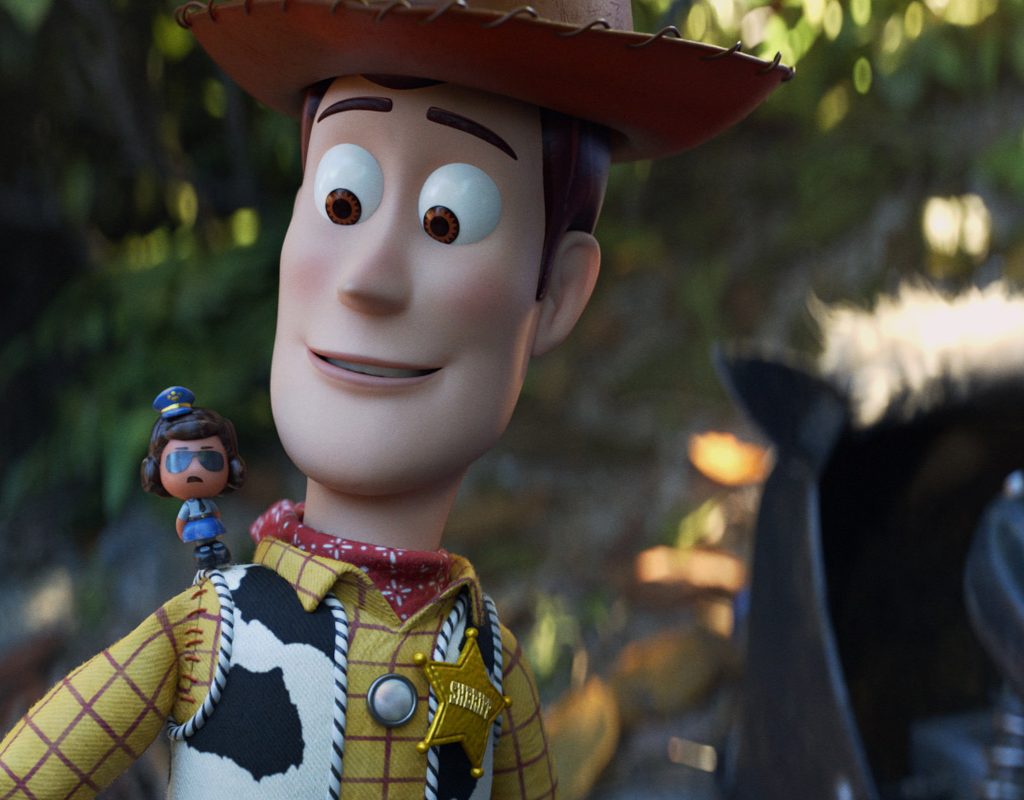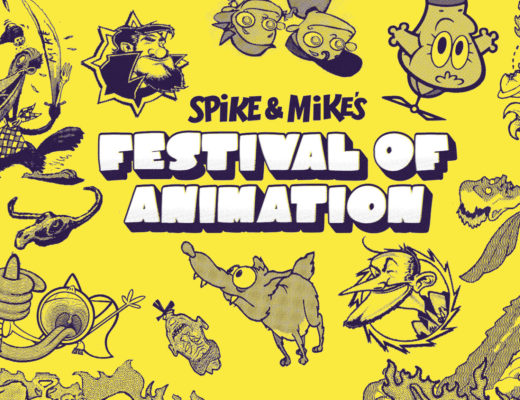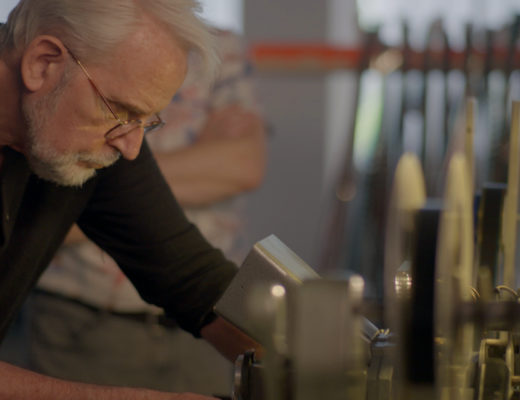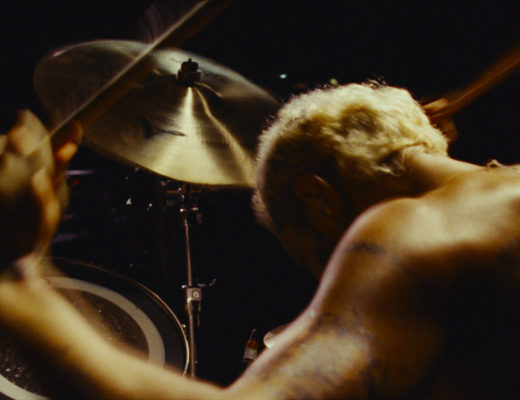Axel Geddes, ACE recently won the ACE Eddie for Best Editing for an Animated Feature Film on Toy Story 4.
Geddes started in live-action editing and has been in animation post at PIXAR since his work as an additional assistant editor on Toy Story 2. He worked as a second assistant on Monsters, Inc. He’d moved to first assistant on Finding Nemo and on Wall-E he was second film editor. He’s edited several shorts and the feature Finding Dory as editor.
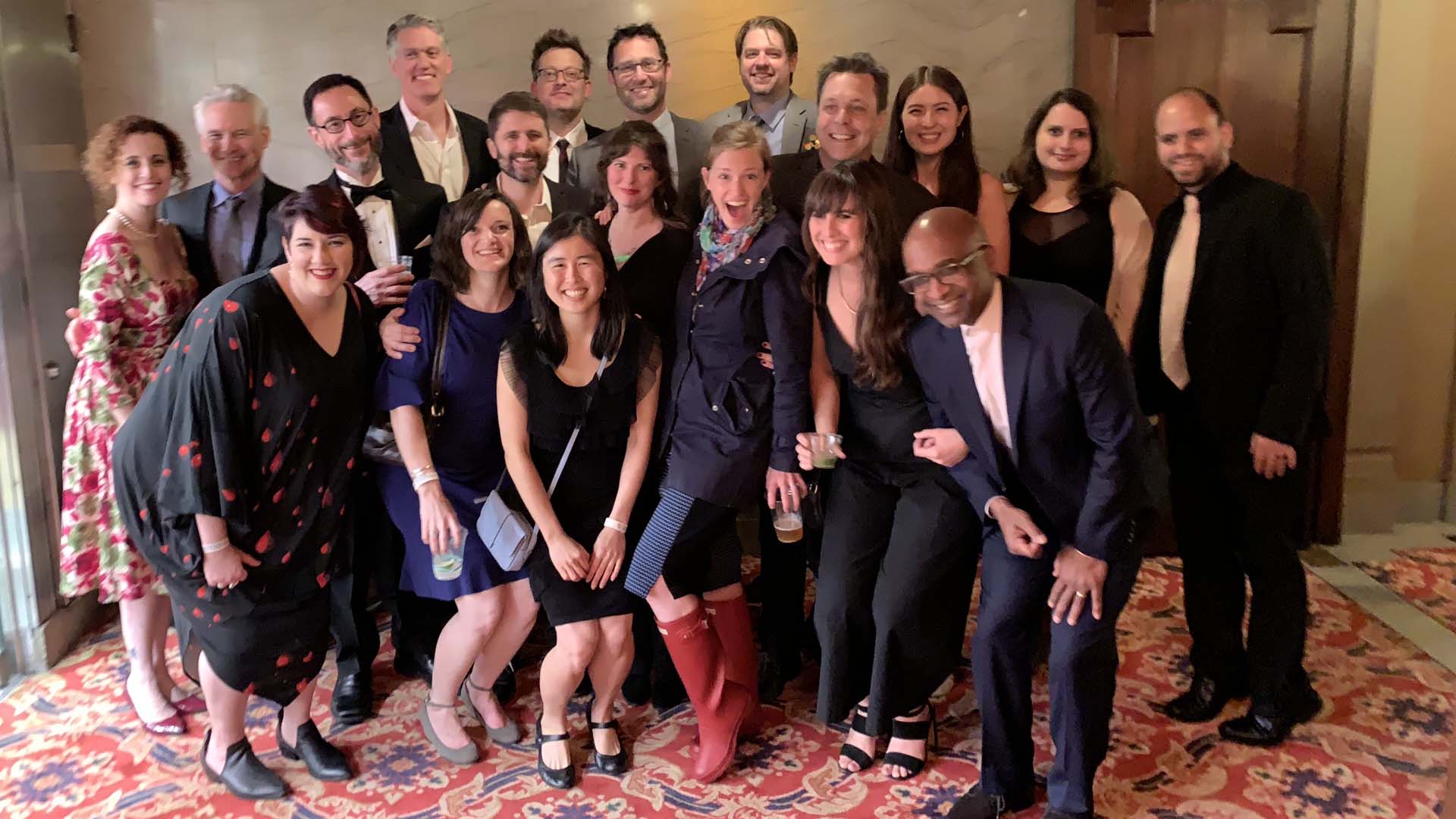
Today we’re primarily discussing Toy Story 4 but we’ll also be getting into some pretty surprising revelations about many of the PIXAR films that went before it.
This interview is available as a podcast.
(This interview was transcribed with SpeedScriber. Thanks to Martin Baker at Digital Heaven)
https://youtu.be/Pl9JS8-gnWQ
HULLFISH: What do you think that your colleagues in the editing world saw in this movie that made them say you need the ACE Eddie. And if you don’t feel comfortable with THAT question — when you’re watching somebody else’s work what makes you think that it is a well-edited film or well-edited animated film?
GEDDES: It’s hard for me to talk about what they saw in Toy Story 4 that made them think it was ACE-worthy. I honestly thought I Lost My Body was going to win that night because it’s such an original, beautiful, poetic film. But I was really proud and excited that Toy Story 4 did win the ACE. It was such a wonderful thing to be recognized that way.
I think maybe what they saw is that we tried to honor the Toy Story franchise — make it feel like a Toy Story film — while also making it not feel like a repetition of previous films. It doesn’t quite have the same kind of clip to it that other Toy Story movies have had. We had some moments of reflection and quieter beats in the movie that are fewer and farther between in the Toy Story movies.
HULLFISH: When you’re looking at other people’s work, what attracts you to the editing or what makes you think it’s a well-edited movie?
GEDDES: What I’m often trying to do is be a truth diviner — try to make sure that what I see on screen is truth for the world that we’re creating and the world that we’re presenting — so I try and look for that in other films.
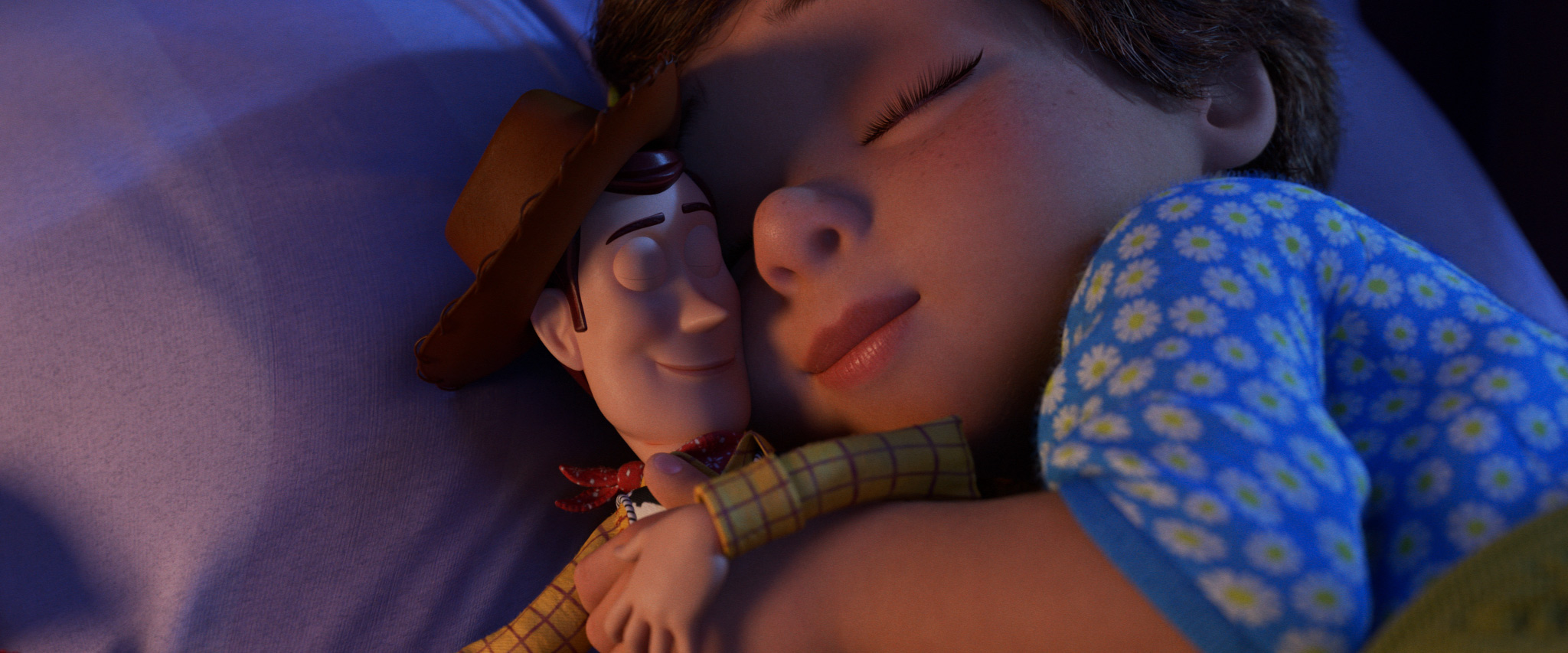 Watching Marriage Story the performances were so true. They felt so honest and real and I would say probably everybody was at their best. And I felt like that was something that the editor — when she was going through it — I think she must have had to go through all the different takes, as you do, and just try and find what felt the most honest and true and like a real moment.
Watching Marriage Story the performances were so true. They felt so honest and real and I would say probably everybody was at their best. And I felt like that was something that the editor — when she was going through it — I think she must have had to go through all the different takes, as you do, and just try and find what felt the most honest and true and like a real moment.
Laura Dern I think was so amazing in that film — what she did. I just felt such a real, truthful and not likable character, which is cool.
That’s what I’m looking for is truth. Truth of emotion, truth within the storytelling, and believability. And emotion over smoothness of the cut or continuity or any of those other things.
HULLFISH: For those people that are not animation aficionados — they don’t understand how the process works — what are the broad strokes of the process?
GEDDES: First, the script is delivered to the story artists. The story artists get handed one scene at a time. Then they interpret the pages visually and they’ll deliver 100 to 400 to 900 boards (drawings) for a sequence.
Then I have to time out the boards with usually temp dialogue — scratch dialogue with our friends and neighbors around the studio — temp sound effects, temp music and then try to emulate what it would be like to watch the movie before we’ve actually made the movie.
We’re making story reels and that’s kind of our job for the first couple of years on the film. Over the course of a four and a half year project, it’ll be about eight or 10 screenings. And in between the screenings, it could be a whole “page one rewrite” or it could be just some tweaking and turning of knobs and stuff.
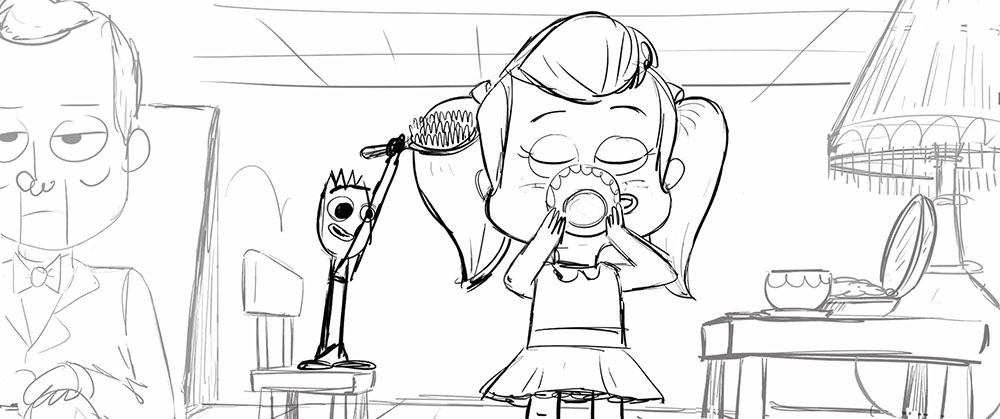 It could be that after a screening you say, “Well, THAT didn’t work!” And throw it all up in the air and start over and then we have to go back and do the whole thing all over again — go back to the drawing board.
It could be that after a screening you say, “Well, THAT didn’t work!” And throw it all up in the air and start over and then we have to go back and do the whole thing all over again — go back to the drawing board.
For a big chunk of editing an animated film, you’re part of the writing process. Editing is always considered the final rewrite, but because you can change so much in computer-generated animation you can rewrite a bunch of it right at the last minute.
On Toy Story 4 we rewrote the entire third act about six months before release. The same kind of events occurred — Woody saying goodbye to Buzz and the other toys — but the way that we did it and the events that occurred to get him there we completely changed and reordered and reconfigured in the last six months. So it’s really like being part of the writing and rewriting process.
Some people have also compared it to workshopping a play. You take it out away from Broadway and you play it for people and get a feeling for what it’s like, then you tweak it, rewrite it, tweak it, rewrite it, and then put it on again until you get it to a place where the ideas I’m trying to communicate with this play are actually getting across.
HULLFISH: It’s interesting that three and a half years into the process you’re still rewriting stuff.
GEDDES: Oh yeah. Absolutely. That’s something we’ve always done to a greater or lesser degree. Some films — like Toy Story 3 — was more like tweaking all along the way. The biggest changes we made were pretty early on in act one because we’re trying to convey the boredom of the toys without actually boring the audience, right?
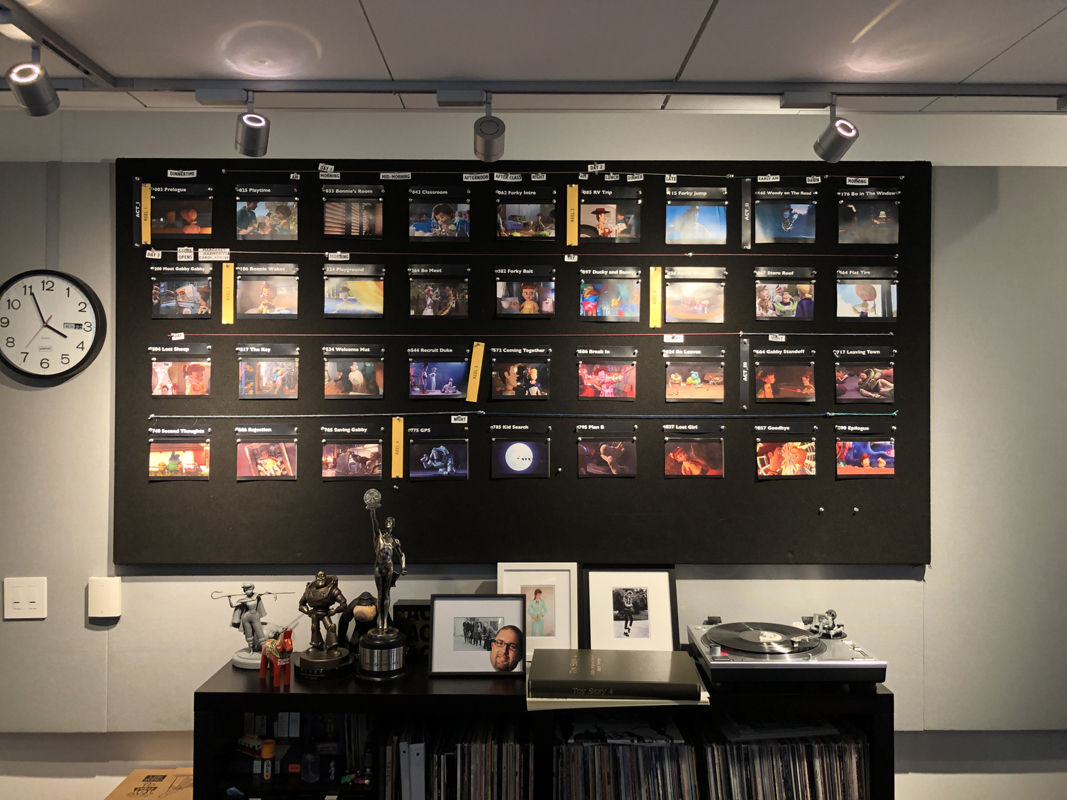
But in Toy Story 4 there was a lot more that was changing all the time because we really wanted to just narrow what the story’s about and what is Woody’s arc and how is he getting to it, because it’s a big move that he makes at the end of the film, so we just need to make sure everything lines up so that it feels truthful and that the audience is rooting for him — even if it’s a little bittersweet — the audience is on his side and wants to see him make this choice.
HULLFISH: In the Pixar offices is there a go-to Tom Hanks scratch voice?
GEDDES: It changes over the years. We do have our go-to. For a long time, Andrew Stanton always did Woody. Pete Docter used to be Buzz but he got too busy, so then you have to find other people. At a certain point Josh Cooley — the director of Toy Story 4 — just became Woody. He sounds nothing like Tom Hanks but you’re not really trying to emulate what Tom Hanks sounds like, you’re really just trying to get the tone of what the beat is.
Ideally, we don’t animate any of that scratch. Sometimes you have to. But ideally, we’re just using it through the storyboarding process to test out whether the ideas are being communicated.
Ideally, you have somebody who’s got the chops who maybe understands a little bit of acting.
HULLFISH: So do you and Josh walk through the offices as you’re going to lunch listening to voices you could throw into a scratch track?
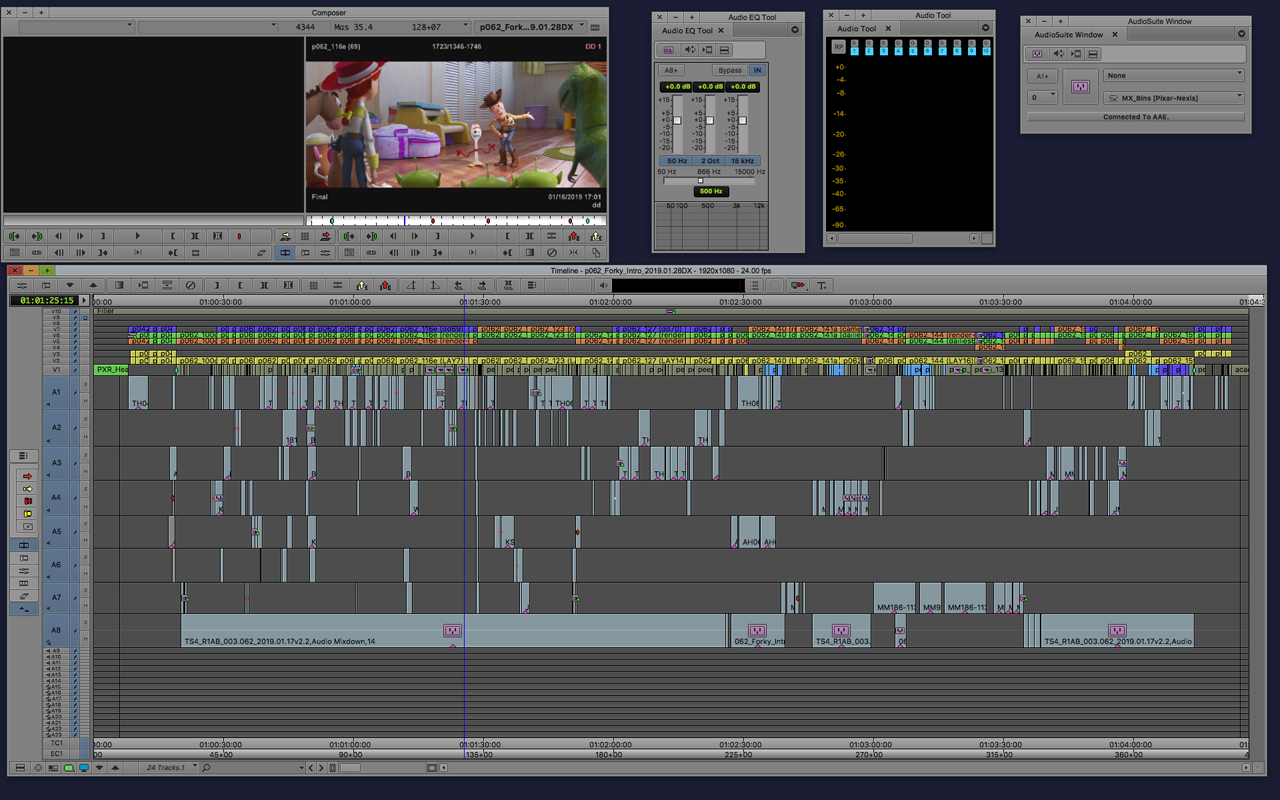
GEDDES: There are times when you find somebody that you think could sound a certain way or might inspire you to actually put a character in the movie that you may not have actually thought about putting in.
HULLFISH: The process at Pixar is the other interesting thing I think a lot of people want to know about. There are many books and even YouTube videos about the storytelling process at Pixar and how the story develops. You’re in the mix of all these story artists and the director. What part are you playing in that?
GEDDES: It depends on where we’re at in the process and how much I’ve got on my plate. I joined Toy Story 4 in the fall of 2016 after the director became Josh Cooley. Almost immediately we had a screening in January of 2017 and I remember spending maybe all of February and a chunk of March sitting in the story room with me, the writer, Josh, the head of story and sometimes other story artists.
What are we trying to do? What’s the message we’re trying to send? What order should we be telling that story in? So I’d be pretty involved with putting index cards on a big pinboard, but they could go on without me if I didn’t show up.
Then once we actually get into pages being written and things being handed off to the story artists, then I’ll be brought in for the handoff to the story artists so that I can see the pitch that they have, and then I can ask for some alt shots or some alt poses or I’ll ask questions about: “What’s the tone here? What are we feeling? What is the intent here?”
When it finally gets delivered down to my department then I can have a better guess when we are first putting it together. Then we work really closely with the story department. We work really closely with Josh. We’ll cut the whole thing together — dialogue, sound effects, temp music — and then I’ll show it to Josh. Usually, the head of story is in my office when we do that.

We’ll usually have a little setup on the side where they can draw. They do most of the drawings in Photoshop now. They’ll do the drawings right there and they can ship them to me and we can iterate and rewrite and re-craft a scene right in my office altogether.
HULLFISH: What are some of the things that you’re requesting in those meetings?
GEDDES: Sometimes I don’t have the acting that I need. Like a “thinking pose” or a dialogue read SOUNDS like one thing but then the pose LOOKS like something else, so they don’t feel like they match.
Sometimes it’s the coverage. I don’t have the shot that is conveying the right emotion or maybe I need a two-shot or maybe I need a shot of the character who’s listening to be able to get a feeling for how these lines are affecting him or her.
Sometimes we’ll get an idea for a gag and we’ll throw it in there. For instance, I remember there’s one scene where Gabby is reading her storybook to Forky and it affects Forky emotionally. I wasn’t quite getting that. We were on a shot of the storybook and you could see her hands holding it and I said to Garrett, the story artist, “What if Forky put his hand on her hand? Then you’d get the feeling that he’s understood what she’s saying and he’s kind of come around to it what her point of view is — he’s showing some empathy.”
Garrett totally got it and I had it like a minute later. We looked at it. We showed it to Josh and he loved it.
HULLFISH: And that is in the film if I remember correctly.
GEDDES: That’s in the film, yeah. There’s a lot of stuff that we will craft that way in storyboards that we then try to emulate when we get into the next stage of production — layout.
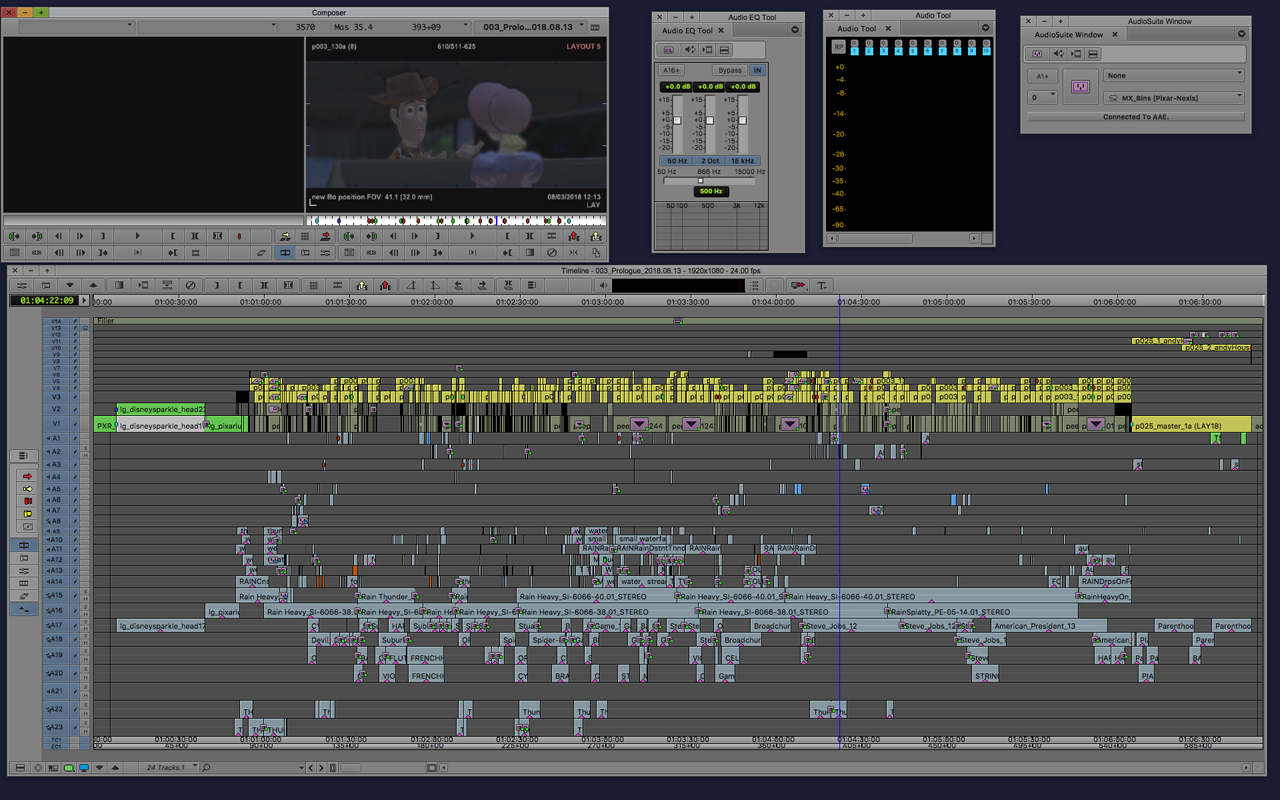
HULLFISH: Could you describe what layout is for people so that they understand kind of what that term is?
GEDDES: Layout is also known as camera and staging. Our directors of photography at Pixar are kind of two different departments. You’ve got your lighting department and you have your camera and staging department. So layout is the camera and staging department and they have to execute camera moves, lens choice and they also have to do all the blocking.
We have usually laid the groundwork in storyboards for the blocking but through the layout process you’re gonna discover a bunch of things when you actually get the characters into the actual 3D space instead of just being a 2D drawing.
You’re going to discover all kinds of things that you’re going to want to then explore. So we will lock a scene in storyboards. We say, “This is the version of the movie we’re gonna make for this three minutes.” We’ll send it to layout. They will analyze what shots we’re using and what we’re trying to convey and then do a location scout.
Then they’ll invite me, the production designer, and the director and we’ll give notes of what we like, what we don’t like, and then they’ll start building shots.
Building shots is blocking; trying to figure you know which lenses. They’ll break the scene down into shots and they send me all those shots and then I’ll just start cutting them like live-action.
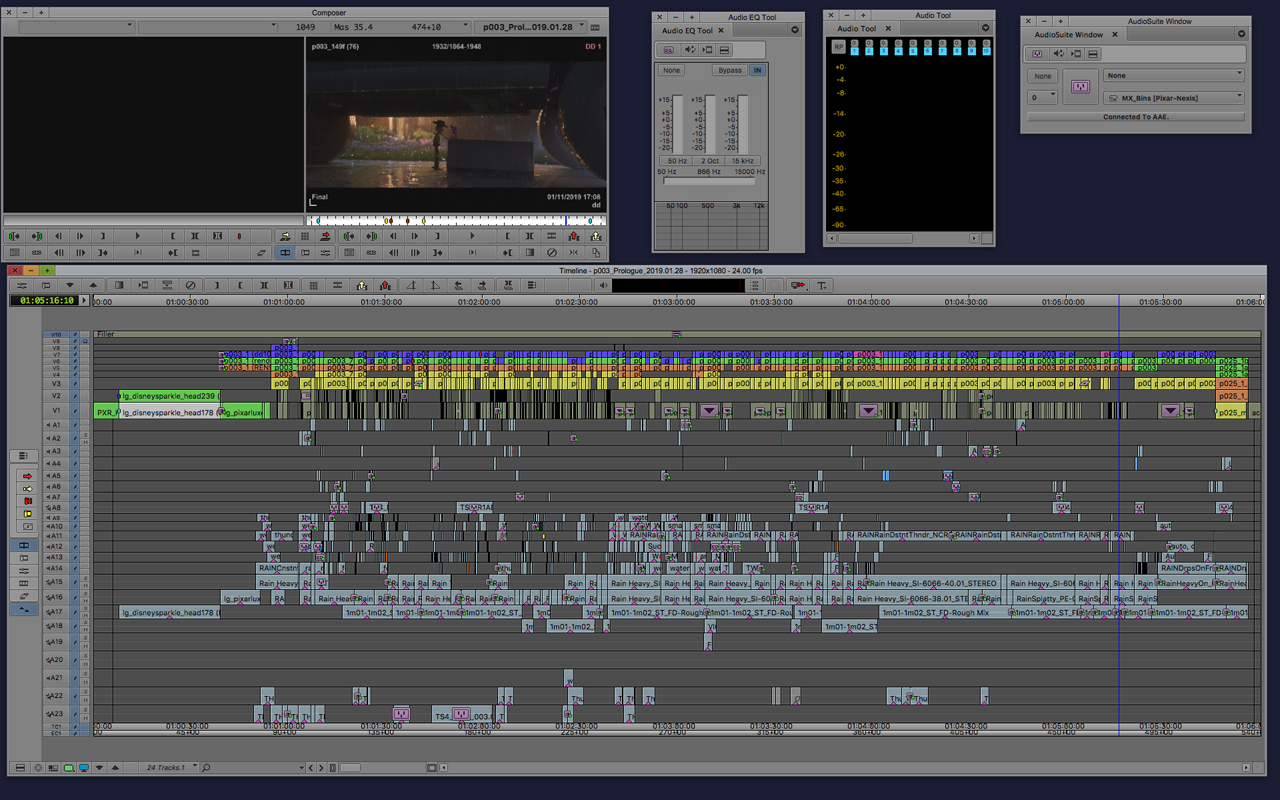
And the beautiful thing about it is that unlike live-action I can get additional coverage. In storyboards, I’m often getting a linear version of this of the storytelling and not a lot of coverage unless I ask for it.
With layout — depending upon the layout artist — I can usually get coverage from different angles and different ways of looking at the scene and I can cut it in a very similar fashion to live-action and then I’ll put together a cut.
Then I’ll sit down with the director of photography and layout and I’ll show them my cut. They’ll ask me, “How come you didn’t use this shot?” And I’ll say, “Well, it didn’t work with this other shot.” And then they may say, “What if I give you a different shot before and a different shot after? Then can we use that shot? Because I think it conveys X meaning.”
They’ll deliver those shots and I’ll cut them together. Sometimes we’ll both like it, sometimes one of us will like it. But we’ll usually come to a compromise where we have something that we really like and then usually we’ll then show that to the director. Ideally, in our minds, we’ve solved 90 percent of the problems before we show it to the director, so the director can then answer some of the questions that we’ve unveiled and then usually ideally they get inspired.
They may even throw out the whole thing when they really get inspired, but that might be because they’re thinking, “Now that I see it in 3D space and I see the characters moving around, now I see a new way that we can approach this whole scene.”
That can be really frustrating for some people because you’ve just spent four weeks building out this scene, but I always get really excited when that happens because I feel like we’ve broken some new ground. This iteration has created something none of us would have seen on our own and together we’ve created something that’s greater than we could have done on our own.
One of the very first scenes I cut at PIXAR was in the first act of Wall-E and I had one of my first reviews with Andrew Stanton.
https://youtu.be/5O9ikywnW6M
We didn’t have any dialogue in that movie — for big chunks of it. This was my first or maybe my second time cutting storyboards. After working for two weeks on it, I showed that scene to Andrew. I put all these beeps and boops and sound effects and I was pretty proud of it.
I was excited about it and I showed it to Andrew and he took a deep breath and he was said, “Here’s the thing. When you’re editing animation, the first thing you have to do is inhabit the character and craft the performance. You have to really be an actor first. And then you can start editing the scene and start thinking about it. So it’s a two-stage process.”
When I thought about that and I looked at the scene I could see that I had edited it too fast. I wasn’t letting the character breathe. I wasn’t letting them think. I told him, Now I understand what you’re talking about. Come back…
HULLFISH: …in a month.
GEDDES: Yeah, right. No, a couple of days. I totally rethought the way I cut the scene and then showed it to him. Then he said, “Great. Okay, now we can start working.”.
It totally unlocked animation editing for me. Because all my experience prior to that — even though I’d been working in the studio for four or five years — all my experience cutting had been live-action before that and so I needed that primer.
When we’re getting into storyboarding we’re trying to put all that emotion and get all those feelings in there. I don’t think of it as storyboarding for camera. I always think of it as emotional storyboarding — storyboarding for beats, for moments, for character arcs.
https://youtu.be/CiTR6RfFkvY
When you get into layout you can lose some of that emotional quality because you might be looking more at “How do these shots cut together? Where is their eyeline? What is the flow here? Are we still getting the story?”
Some of our layout artists are former animators and their blocking is amazing. Everybody’s blocking in the layout department is so much more advanced than it was when I first started here when it was like all T poses gliding through the scenes.
So it will take a step backward and we will oftentimes — once we lock it for animation — we’ll oftentimes have to tell them to go back and look at the storyboard version of the scene to see: “This is what the intent was” Even if we’re covering it in a completely different angle or a completely different camera move, we still have an emotional intent that we’d figured out over in the storyboarded version.
It’s on the director; it’s on the animation supervisors; it’s on the editor to keep track of those emotional beats to make sure that we’re hitting all that stuff and we don’t lose it. Because the animator gets it and they’re in a bubble. They might have three or four shots but they’re not looking at the whole. And so when it comes back in you try and see it early enough that you can adjust it and give them notes so that it actually stays on track and tells the same story we’ve been trying to tell.
HULLFISH: The people who are drawing the storyboards are drawing expressive faces but the layout stage is pretty wooden. Do you get changing expressions in layout nowadays?
GEDDES: It depends on what the shot is about. Sometimes we will add an expression because right around this beat we want this like little micro-expression to happen or something. We might ask the layout artist to at least give an indication of that timing. Sometimes we’ll just tell the animators, “Go back to storyboards and look at that.”
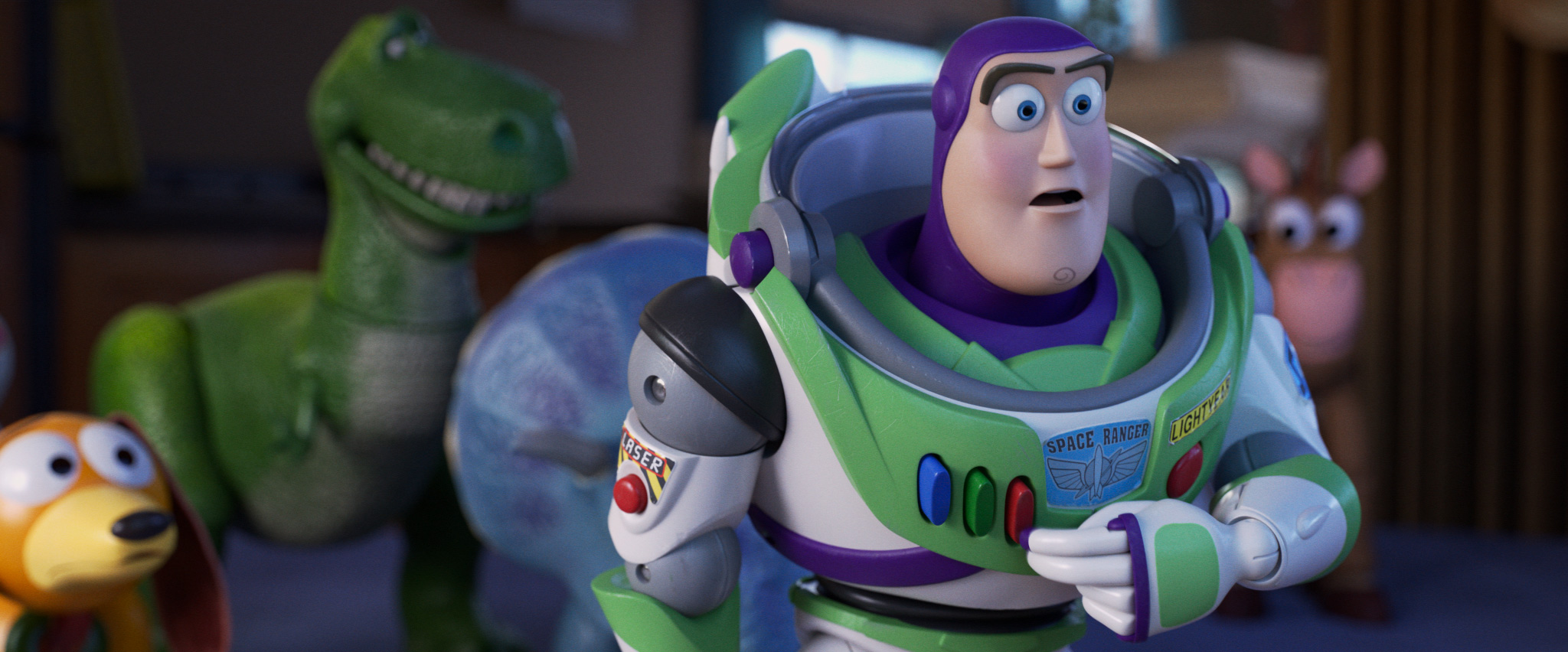 And then also, when the director hands that scene off to animation they’ll go through each shot and say, “This is what’s happening here. This is what our intent is here. This is why this shot is in the movie and what we’re trying to convey to the audience at this moment and this is how the character is feeling.”
And then also, when the director hands that scene off to animation they’ll go through each shot and say, “This is what’s happening here. This is what our intent is here. This is why this shot is in the movie and what we’re trying to convey to the audience at this moment and this is how the character is feeling.”
Just the way a director has to communicate with an actor in live-action, an animation director has to communicate to the animator.
We try not to have audience previews with layout in them because there’s a lot less emotion in them but sometimes you just run out of time and you need to do it.
HULLFISH: So you warn the audience a little bit and move on.
GEDDES: Yeah. We always have to train the audience for audience previews with like a little progression reel: “You’re going to see some things that look like this.”
HULLFISH: There’s a great editing moment when a baby carriage flips over and a woman looks inside and there’s a jump scare. How much did you have to tweak that? How is that so effective? Tell me a little bit about that scene.
GEDDES: That one we tweaked a bunch. We had temp music that hit that beat and then working with Joe E. Rand, the music editor, and working with (composer) Randy Newman to make sure that that worked just as well as it did in the storyboards — because that’s one of things you have to track is: we made this work in the storyboards, let’s make sure we don’t lose that as we get it down through production.
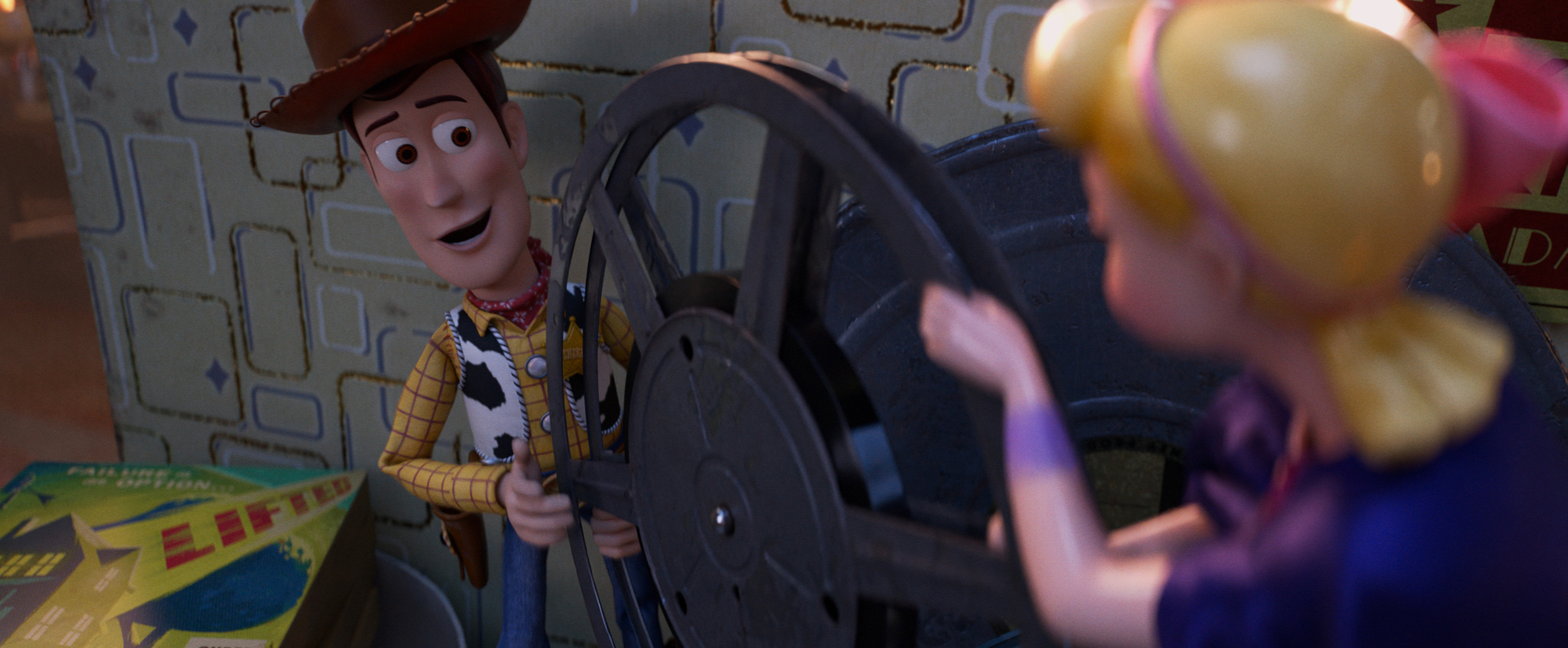 But I remember that might have been one of the last things that we locked timing for because I shipped it long — those shots — so that I could have the ability to be able to tweak it and shore it up. I wanted the flexibility to be able to find that timing.
But I remember that might have been one of the last things that we locked timing for because I shipped it long — those shots — so that I could have the ability to be able to tweak it and shore it up. I wanted the flexibility to be able to find that timing.
That was in reel 6, which was act three. That was one of the things that where we were tweaking back and forth, back and forth. Also, the moment when Duke Kaboom is jumping over the carnival and we have that big drawn-out moment with him having his glory and then hitting the light at the end.
Hitting that light was funny, but it was not working because we were not seeing him hit the light because we’re going too fast. I kept going back and forth with the animation lead, Nate. We were trying to figure it out and at one point I just pressed play and pause on the Avid (scrubbing forward at 1/8th speed) and I was just kind of joking but it worked. It was actually really funny. So I just timed it out and shipped it back to animation. They just emulated that timing, and after that it was funny and the audience could track with it.
HULLFISH: It was a gorgeous sequence, but it couldn’t go on forever. You needed to figure how much it could withstand.
GEDDES: You can’t go on forever but you want to milk it for all the gags and all the fun because you’ve got this bittersweet ending. So you want to be able to pepper these jokes and gags and entertainment leading up to that. So the audience will feel like they’re ready for those moments that we — as filmmakers — know are coming.
You play around with all that stuff and sometimes you cut it back too far and then you watch it. I always try and get a big head start — like 5 or 10 minutes before.
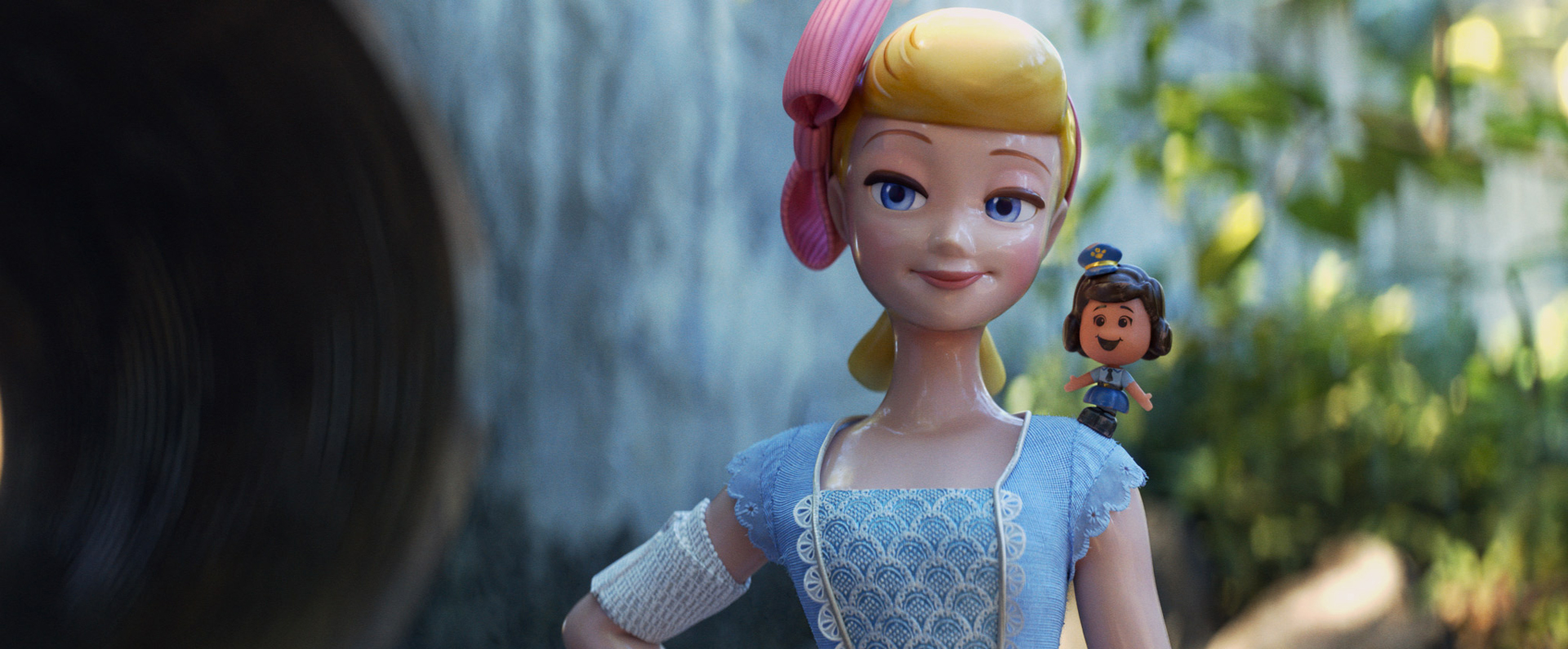 Instead of just looking at it by itself, you want to look at it holistically. Get a real nice run up to it and then get the feeling for it. That’s just part of the process.
Instead of just looking at it by itself, you want to look at it holistically. Get a real nice run up to it and then get the feeling for it. That’s just part of the process.
HULLFISH: That’s a great tip. Don’t just pre-roll five seconds.
GEDDES: Oh yeah. Context is the thing. I try and show as much of the movie as I possibly can in my office whenever I can because we’re not making a sequence. We’re making a feature film. If you spend too much time just looking at three minutes of the film, then each sequence can feel disconnected from the next and from the previous. So that’s one of the things that’s great about having our process of having the screenings because you’re looking at the film holistically.
You discover that there’s a problem in some scene where you might think the scene works great. But when you look at it in context with the whole movie you ask, “Why doesn’t that scene land?” It may be because you haven’t laid the tracks yet to get there. Or maybe there’s a problem with that scene. Maybe it’s too much talking. Maybe it’s not enough — or the right talking. Maybe it’s the music. Maybe it’s the tone. Maybe it’s the pacing.
You have to analyze all that stuff. But if you do it in a vacuum and it’s just one scene, you might be making choices that are not actually helping you.
Somebody said something about a movie recently that I thought was really funny: They said the movie was cut so fast that it felt long. You’re losing their attention because they can’t get a grasp on the beats. They feel a little bit behind and at a certain point the audience says, “If the filmmakers don’t care. Why should I?”
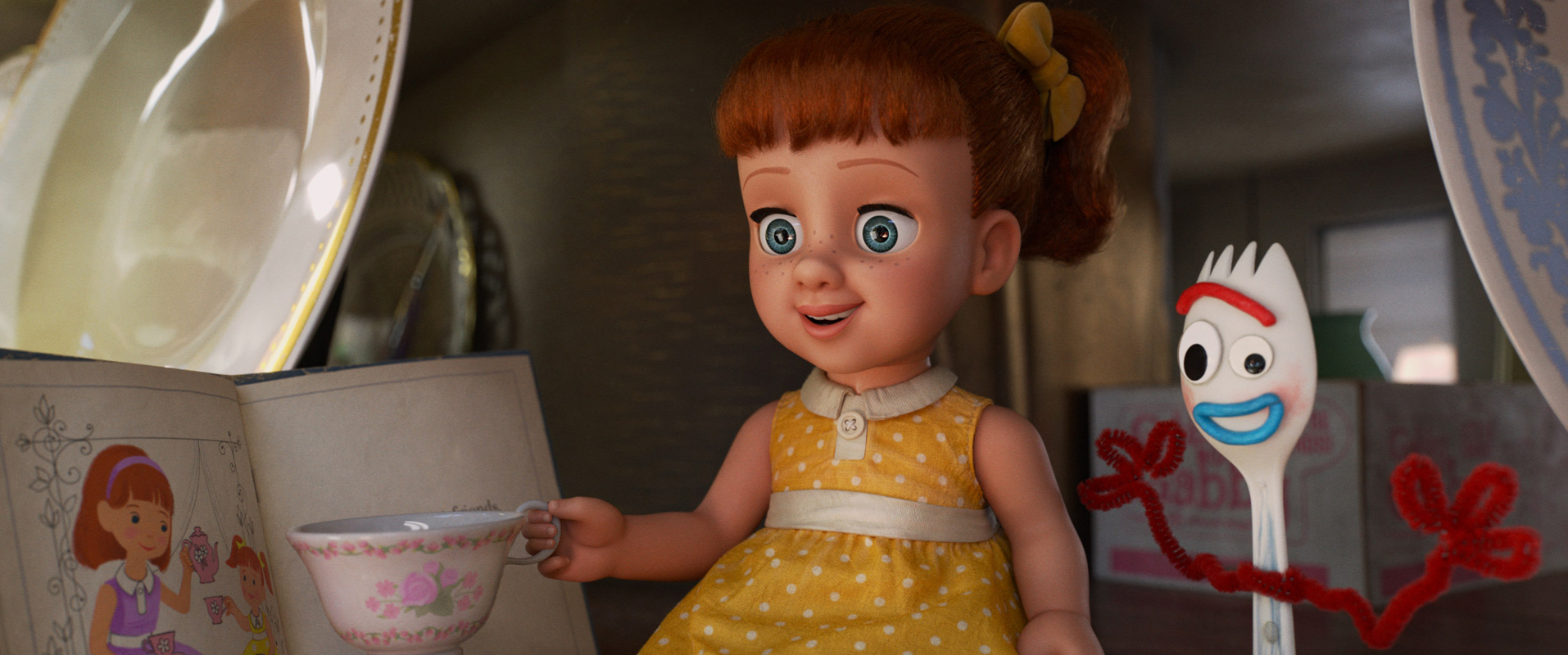 HULLFISH: One of the other places that I really liked emotionally and I felt like it worked because of timing and pace and a lot of things is a big scene with Bo and Woody and Gabby in a box at the antique store. Can you talk to me about the conversations that went on around that or how you guys knew you got it just right? I feel like you really got that scene just right.
HULLFISH: One of the other places that I really liked emotionally and I felt like it worked because of timing and pace and a lot of things is a big scene with Bo and Woody and Gabby in a box at the antique store. Can you talk to me about the conversations that went on around that or how you guys knew you got it just right? I feel like you really got that scene just right.
GEDDES: That’s lovely to hear.
HULLFISH: That scene made me cry.
GEDDES: I love that. Of the things I really wanted to do is see if we could redeem our villain in the movie and to really have empathy for her.
That’s part of that scene we were talking about with Forky putting his hand on Gabby’s. That scene was really about Woody making a choice that he needs to come back and help Gabby. Woody has had this whole life where he’s been loved not by one but by two kids and that’s a place of privilege. So he’s had like a lifetime and a half.
That scene is really about Woody trying to convince Gabby that a chid’s love is worth shooting for and worth trying for. We had that beat of them listening to the carnival sounds of happy kids outside and we’d tried that in a number of different screenings in different areas of the film — trying to convey that idea through different characters.
Finally, we found this moment where we could use that as a way to convince Gabby emotionally that there is love out there for her and she’s worthy of it. We need to emotionally feel it — as opposed to just say it.
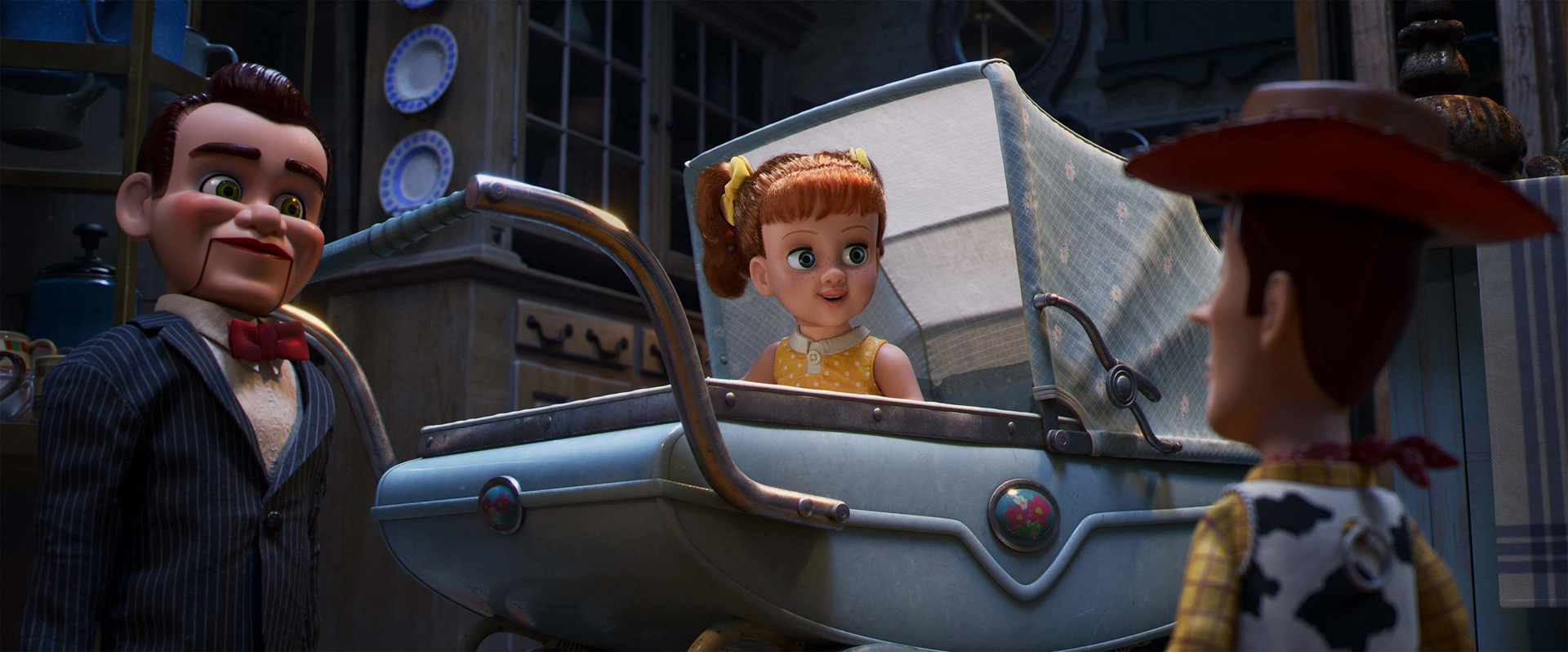 We tweaked that speech with Woody a lot. We were recording with Tom Hanks in December of 2018. We were rerecording that speech and a speech towards the end — after they see Gabby with the little girl at the carnival.
We tweaked that speech with Woody a lot. We were recording with Tom Hanks in December of 2018. We were rerecording that speech and a speech towards the end — after they see Gabby with the little girl at the carnival.
I remember we were going back and forth and rewriting and retrying and tweaking all the lines and it was supposed to be our final recording session with Hanks. He looked up at us and said, “Guys. I don’t think we’re there yet. Why don’t you book another hour with me in the new year after you’ve figured out exactly what you need here.”
It was great for him to give us his time. It’s precious. And also to give us the understanding that he knew we would figure it out. He gave us the tether that we needed in order to be able to explore a little bit.
We reworked that scene with the writer and then we recorded him again in January or February. But the combination of all those pieces were all things that we had been playing around with. When does Bo come back? Woody was kind of a jerk to Bo in the alley and why did she come back? So we had to rework the scene before it when they go under the carousel.
All of those were really very tenuous pieces that we needed to make sure held up well. So we kept on rewriting, rewriting, rewriting right up to the last second.
HULLFISH: The audience has to know that Gabby getting the soundbox is not going to solve her problems, right? That’s a difficult balance to not let the audience get too far ahead of you but maintain the tension.
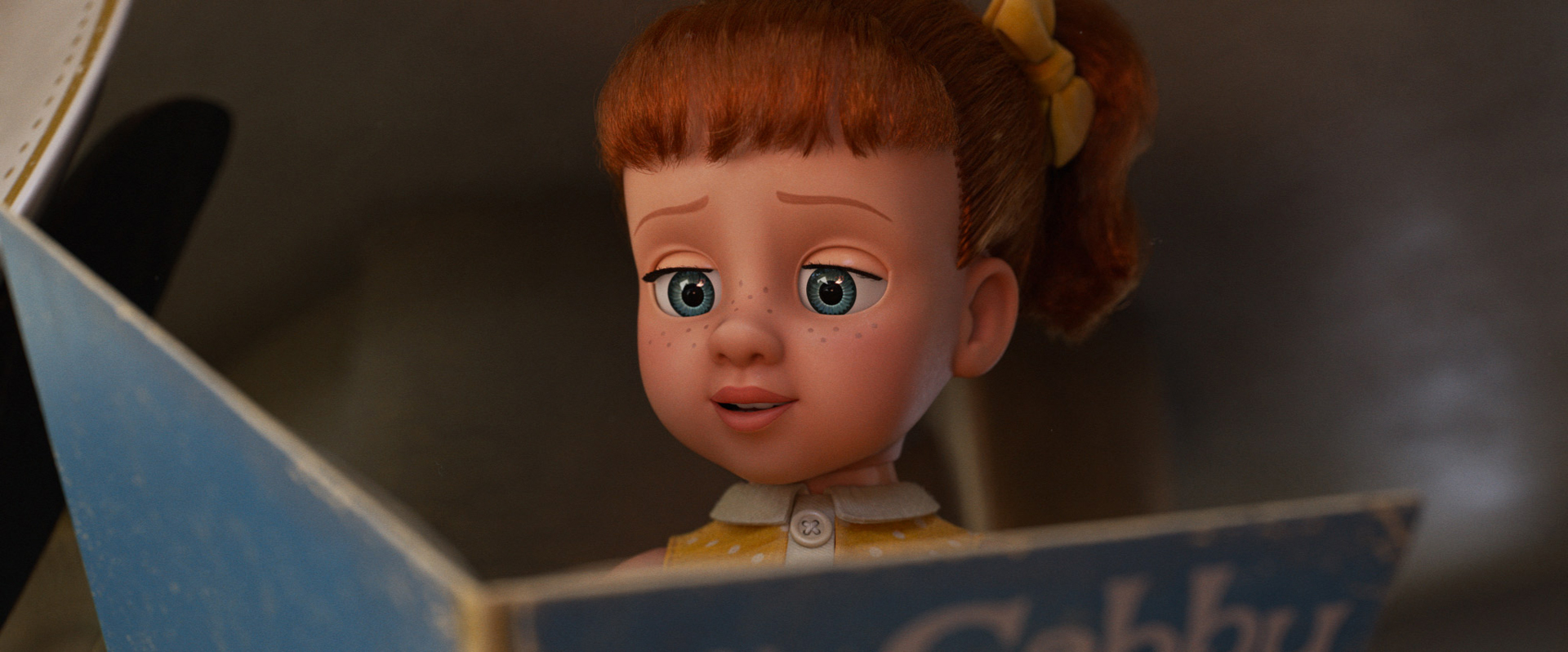 GEDDES: I think the audience may know that it’s not going to solve her problems emotionally but I don’t know if they know it intellectually, because what they’re really worrying about, I think, is what does that do to Woody? Their emotional center is with Woody. So they’re more worried about what the threat is to Woody because he’s our main character.
GEDDES: I think the audience may know that it’s not going to solve her problems emotionally but I don’t know if they know it intellectually, because what they’re really worrying about, I think, is what does that do to Woody? Their emotional center is with Woody. So they’re more worried about what the threat is to Woody because he’s our main character.
SPOILER
We also had to rewrite and rework the story that Gabby tells Woody in the back of the antique store to get his voice box. Because not only does Woody need to be convinced to give that up, but we, as an audience, need to be convinced that when he gives it up that we’re all okay with that.
In any film — and any storytelling — the audience needs to know just enough in THIS scene that you’re watching right now to want to watch the NEXT scene. If you give them too much information then they resent you. They just see exposition: “Why are you telling me this? I’m not going to retain any of that information. Why do you keep saying it?” So I think you’re always trying to balance that.
HULLFISH: Did you ever have some kind of resolution to him losing the voice box? Because in the story there is no consequence to him losing the voice box.
GEDDES: We tried a bunch of different stuff. A long time ago we had a version where Woody went back with Bonnie and she accepted him anyway without his voice box.
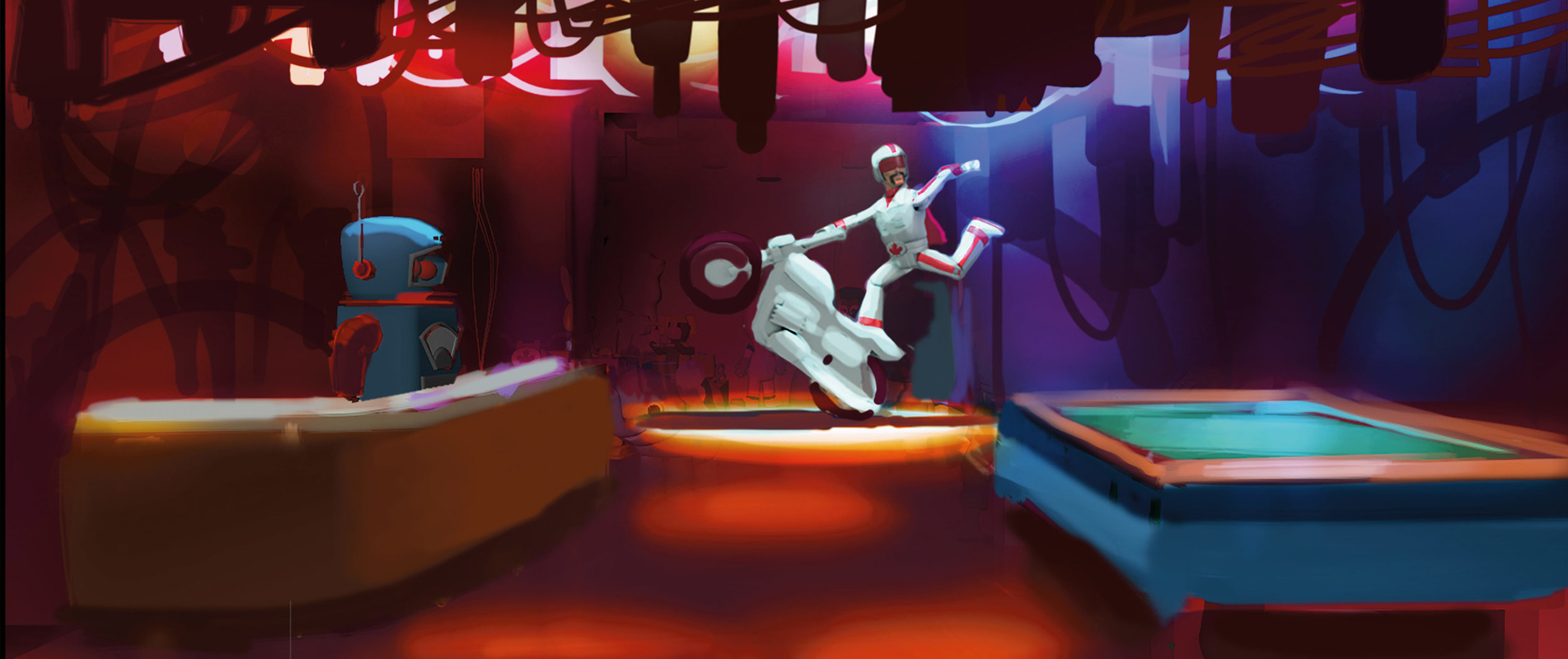 It was actually pretty touching. She picked him up and turned him over and she saw that he didn’t have his pull-string anymore. Then she turned around and spoke in his voice — “You’re my favorite deputy!” She started doing his voice and it was pretty sweet but it just wasn’t the right choice for the movie we were making.
It was actually pretty touching. She picked him up and turned him over and she saw that he didn’t have his pull-string anymore. Then she turned around and spoke in his voice — “You’re my favorite deputy!” She started doing his voice and it was pretty sweet but it just wasn’t the right choice for the movie we were making.
And there were versions when he was rejected for having no voice box. But ultimately what the movie told us it wanted was that he gives up his voice box willingly regardless of what it means. And he’s going to take his chances about whether Bonnie loves him or not without it. But then he’s gonna make a choice to go with Bo and try and do something more with his life because he has seen the power of his matchmaking with the little girl at the carnival and Gabby.
He sees this whole other world out there and that he can do something completely different with his life. He has a little more agency than a normal toy does. And I think Bo shows him that over the course of the film and that became our second act.
END SPOILER
HULLFISH: I’m struck by our conversation — two dudes talking so much about emotion. (both laugh) From an emotional standpoint, what makes a good editor? We can talk about pacing and timing and all that stuff, but so many of my conversations center around emotion and empathy.
GEDDES: Without empathy for the characters and without emotionally connecting, audiences don’t care about the movie. We’re asking audiences to kind of step into somebody else’s point of view when you’re watching a movie and to kind of get a new perspective on the world.
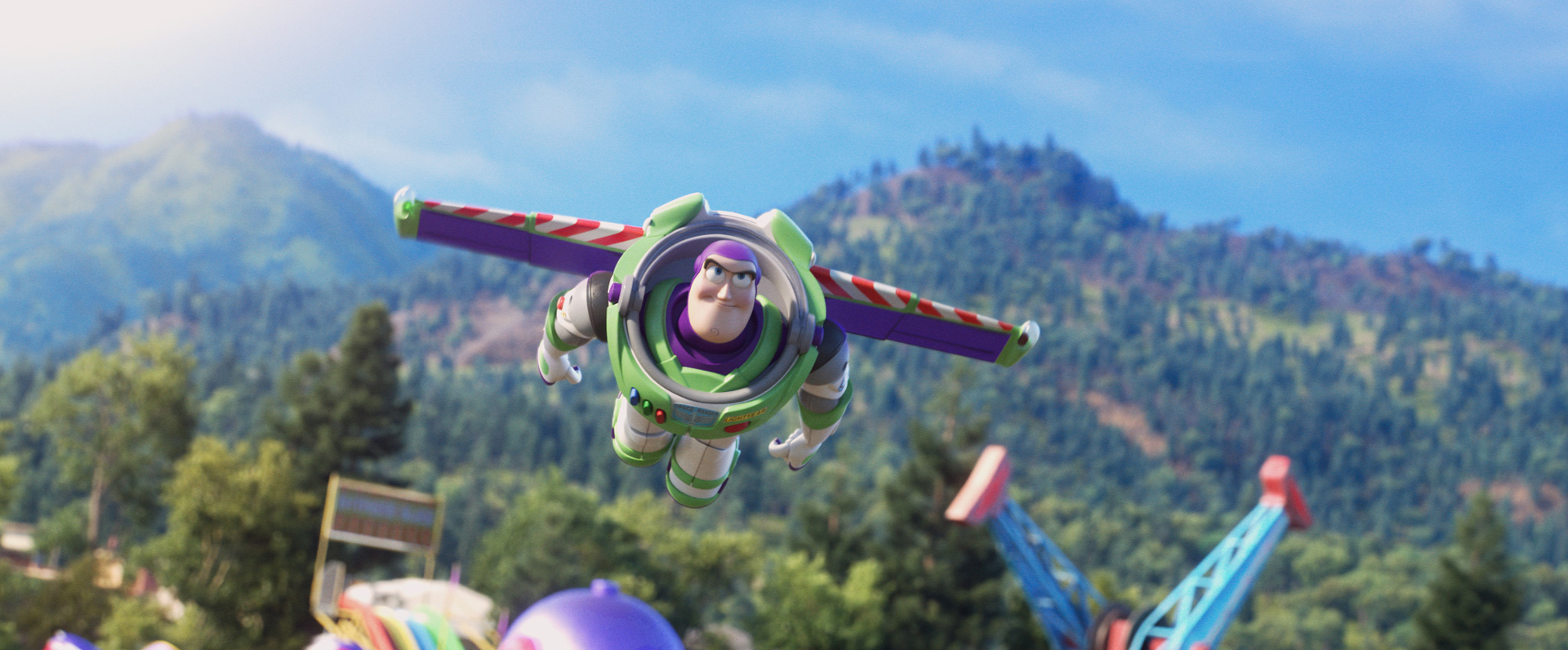 That’s one of the things I love about movies over any other of the film art forms. In a perfect world, you can walk into the theater with one kind of thought about the world and then you can walk out two hours later with a slightly different perspective on things. And I think you don’t get that if you don’t have an emotional connection to the character or the characters that are within the film and you don’t get that if you don’t get to see through their eyes for just a moment. And I think that’s what continues to make cinema magical.
That’s one of the things I love about movies over any other of the film art forms. In a perfect world, you can walk into the theater with one kind of thought about the world and then you can walk out two hours later with a slightly different perspective on things. And I think you don’t get that if you don’t have an emotional connection to the character or the characters that are within the film and you don’t get that if you don’t get to see through their eyes for just a moment. And I think that’s what continues to make cinema magical.
I think it’s true in a live-action film like Parasite or Marriage Story or Ford versus Ferrari or something like that. And it’s true in an animated feature at their best: I Lost My Body or Toy Story 4. You’re getting to see somebody else’s perspective and you’re inhabiting their point of view and you’re getting a new take on the world that we live in.
HULLFISH: Was that kind of what Andrew Stanton was trying to get at when you were cutting that Wall-E scene? Or was it more performance? Was it the emotion that you weren’t getting?
GEDDES: I think it was the emotion. I think that comes through empathy for the character and understanding what they’re feeling, what’s their thought process? And it was particularly tricky in Wall-E because there’s no dialogue. You can’t rely upon exposition in the same way that you can in other films. You have to convey it with visual storytelling.
Steve Schaffer was the lead editor on Wall-E and he was still busy finishing Incredibles, and I think he helped out on Cars for a little bit. And Ben Burtt wasn’t on the film yet, so we were just trying to figure out how do you communicate these things with just beeps and boops and stuff like that.
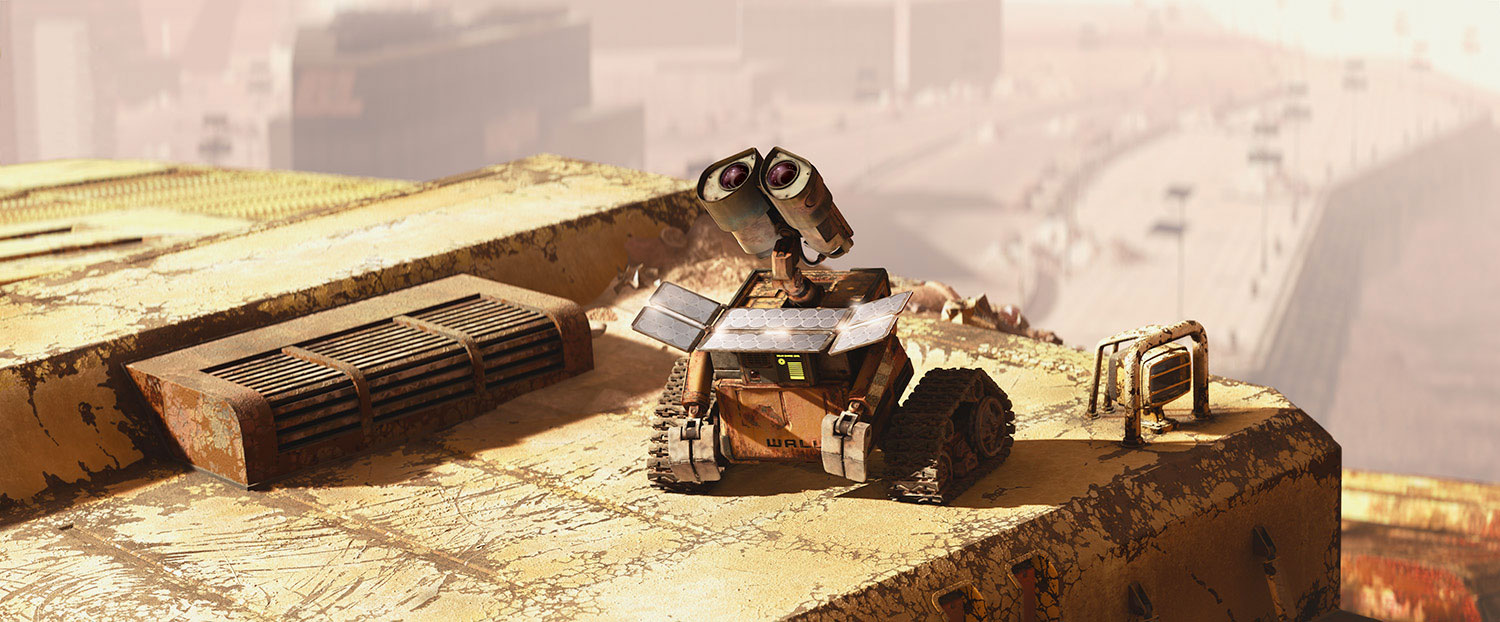 One of the things I think we realized pretty quickly is that if you want the audience to know what the character is saying you’re not going to convey any real information with those beeps and boops, but you can convey emotion. So you have to be really clever about your camera placement and your staging and what your characters are doing and the way Wall-E’s eyes moved up and down — that stuff is conveying more emotion than anything else. And I think the only way to do it is to inhabit it as the editor; as the story artist; and then as the camera department and as the animators later on.
One of the things I think we realized pretty quickly is that if you want the audience to know what the character is saying you’re not going to convey any real information with those beeps and boops, but you can convey emotion. So you have to be really clever about your camera placement and your staging and what your characters are doing and the way Wall-E’s eyes moved up and down — that stuff is conveying more emotion than anything else. And I think the only way to do it is to inhabit it as the editor; as the story artist; and then as the camera department and as the animators later on.
HULLFISH: When you’re switching from something like a sequence made with layout to a final lit scene — I think of something like that big wide shot of the inside of the antique shop that was just gorgeous, the reflections and all that stuff — and you’re looking at probably something much more wooden before that stage. So you figure that scene deserves two seconds and then later on — when you get the gorgeous lit and rendered images — you think, “I wish I had 10 seconds”.
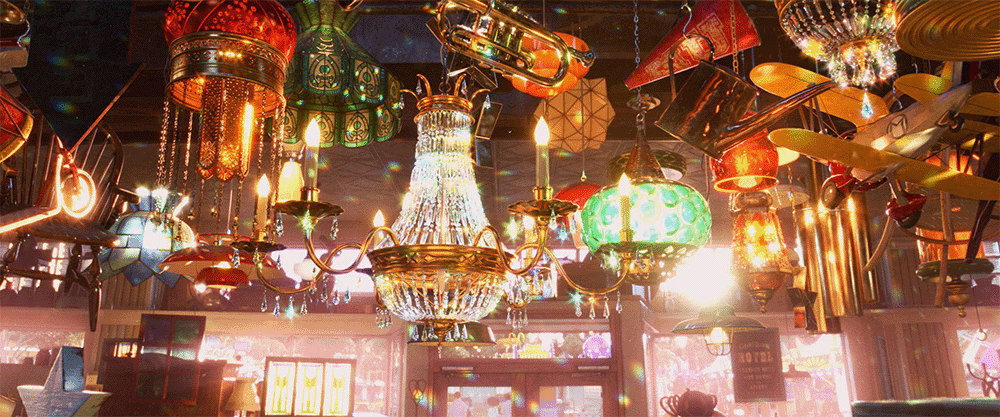 GEDDES: The scene where Woody and Bo are looking up at the chandeliers is one of the shots that I had to extend later on — much to the chagrin of Bill Reeves who continually said he didn’t want any chandeliers in the movie because they’re very, very hard to execute.
GEDDES: The scene where Woody and Bo are looking up at the chandeliers is one of the shots that I had to extend later on — much to the chagrin of Bill Reeves who continually said he didn’t want any chandeliers in the movie because they’re very, very hard to execute.
And that is the most expensive shot in the movie frame for frame. We wanted more of that shot. We needed more of it. Carrie Hobson — one od our story artists — was adamant that we needed that scene in the movie. She really fought for it and she was a hundred percent right.
We needed that scene in the movie in order to convey this connection between Woody and Bo — for Bo to really pitch her idea of what the world is and what life could be for a toy and for them to share a moment of beauty. You have the music. You have the speech. You have them looking into each other’s eyes. But it’s really looking up at that beautiful scene of the lights and the sun coming through. It’s a typical romantic kind of shot. You’re right. We had to extend it. I think I extended it by another two seconds.
HULLFISH: So, what if it cost PIXAR another $$100K! ( both laugh)
It’s the reverse of the old story that I hear from so many editors that they don’t go on the set because they don’t want to know, “This shot took eight hours to set up,” and then they’re not going to use it.
You’re saying, “I don’t care that the render on those two seconds is going to be expensive and difficult.”
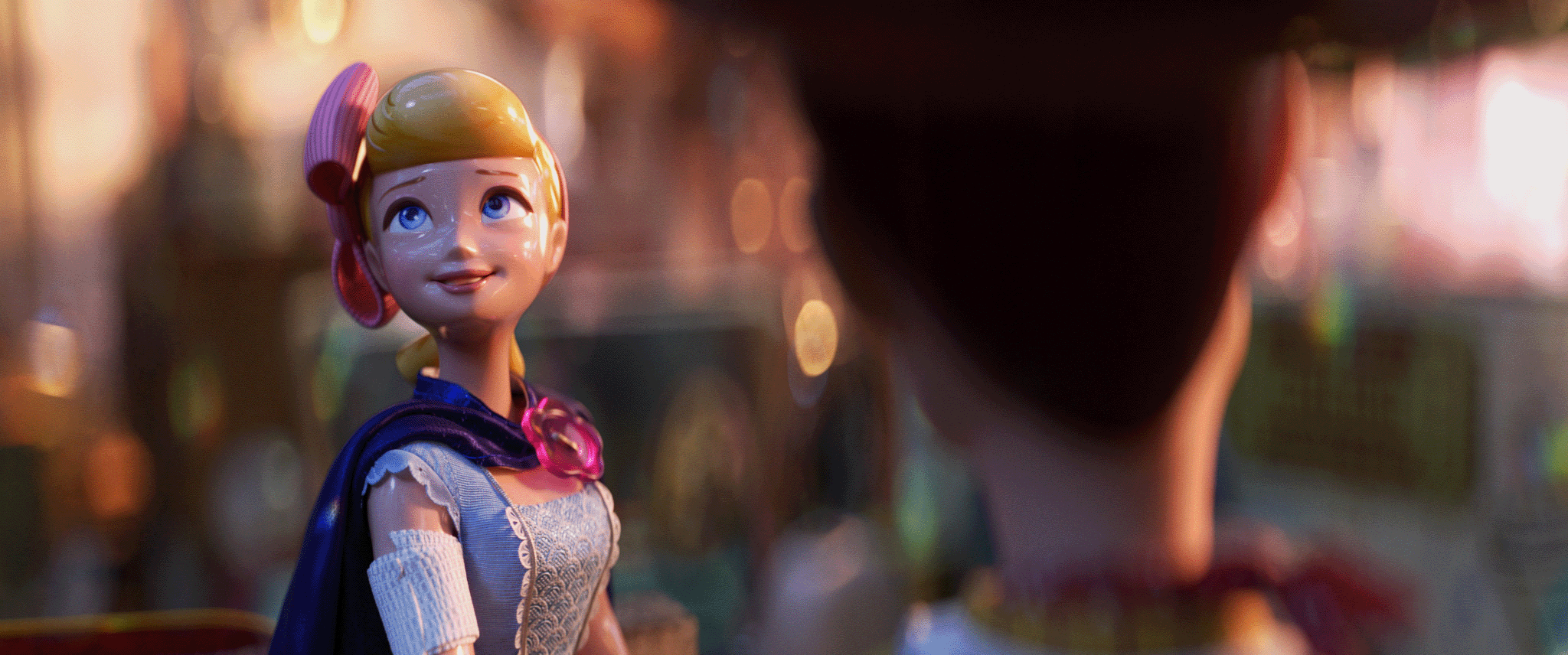 GEDDES: I need more of it!
GEDDES: I need more of it!
We had to cut out a whole scene out of Dory that was complete. It was finished and final. It was the first thing that we had put into layout. It was the first scene we finished. It was in the first act and we realized, “It’s taking forever for act one to start and it’s taking forever for Dory to get on her journey.”
https://youtu.be/iG0P6bjyUNI
It was a scene called Sleep Swimming and watching her sleeping was not helping our pacing issues. (laughs) If I knew how much that scene cost maybe I would have felt reticent, but that’s not my problem.
HULLFISH: So for those Pixar fans that tell me a little bit about the sleeping scene that got cut out. What was in it that was great that somebody obviously decided it was a great scene?
GEDDES: In that scene, we wanted to feel like Dory was being pulled. She had had this moment where she suddenly recovered a memory, after being pulled into the manta rays and she got knocked unconscious and she had this memory of her parents and then we wanted to feel that pull. That scene was trying to show that it’s bothering her so much she can’t even sleep.
She’s being pulled away from her for a current home with Marlin and Nemo and pulled out into the open ocean and they’re frustrated — almost like parents are with a toddler who gets up in the middle of the night.
We got a note that we needed to shorten act one and we need to get their journey going sooner. I think it was Angus — the co-director — who said, “Oh we don’t need Sleep Swimming!” I think he was joking but maybe he wasn’t. I don’t know. It may just have been a provocative statement. But I said, “Hold on a second. I think you might be right. Everybody out.” I spent two days trying to craft it all together — and it was like a crappy version of it — but just to sell the idea that we could go straight from her having the memory to her saying to Marlin and Nemo, “Help me find my parents.”
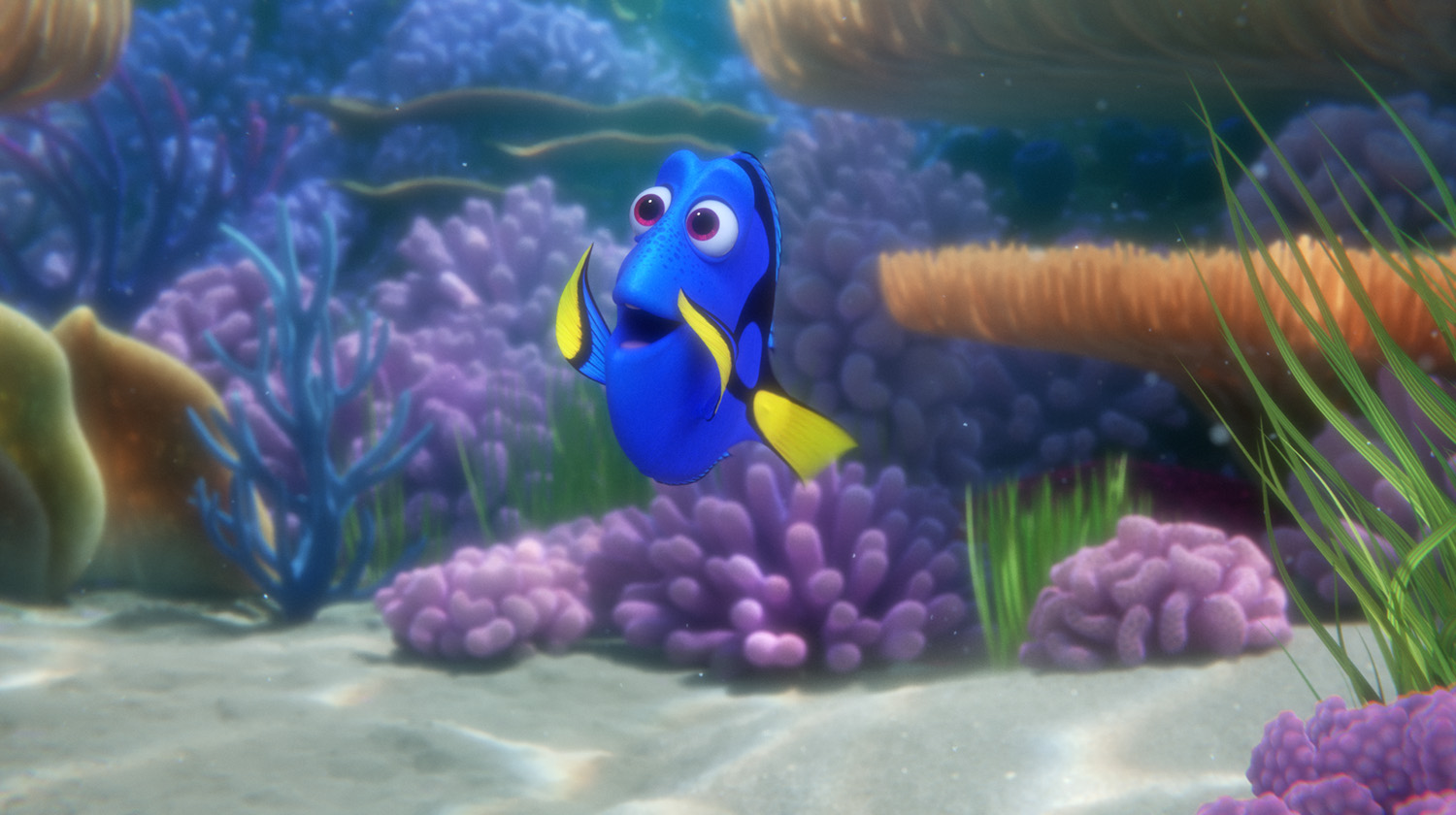 There were a lot of problems in that movie with telling the story because it’s a movie about a character with short term memory loss and so how do you keep that character engaged? We tried a bunch of things and that was one of the many things we tried to try and sell this idea for having a memory recovery and then that launching her on her journey.
There were a lot of problems in that movie with telling the story because it’s a movie about a character with short term memory loss and so how do you keep that character engaged? We tried a bunch of things and that was one of the many things we tried to try and sell this idea for having a memory recovery and then that launching her on her journey.
HULLFISH: I’m sure that when you cut that out, that would be another contextual thing where you can’t just cut it out and watch 30 seconds after the cut. You’ve got to watch to see how it affects the whole movie.
GEDDES: Yeah. That one I remember we watched the whole first act into the first scene in the second act just to get a feel for where it was going.
And then the next big one we did on that was about nine months from release, we recut the entirety of the movie because we took the prologue — that had been the entire story of Dory and her parents, about a five-minute scene and we just shipped it to animation but it told the whole story of her being with the parents and her parents trying to teach her about shells and teach her about staying away from the jetstream — but we, as an audience, weren’t able to retain all that information and it was frustrating for us as an audience because we’re thinking, “When is she going to remember all this stuff?”
So we did an experiment in editorial. We took that prologue and we broke it up throughout the movie and treated the moments and the beats like memories. And then when she got to a new location she would have one of those memories. So each one of those beats — when she got to a new location after she’d remembered her parents after the rays — she would get those beats and then we screened the movie.
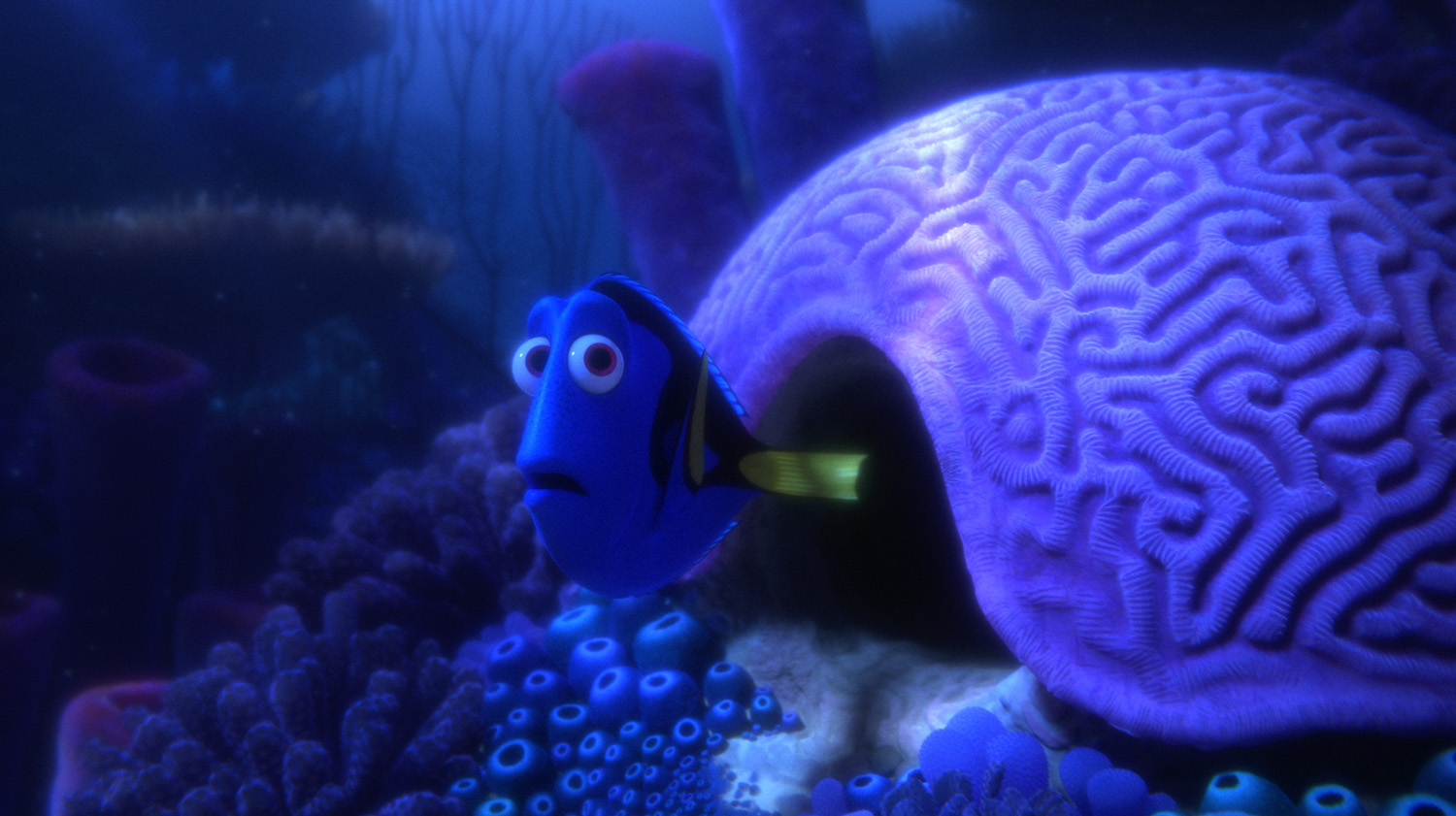 That time we screened the whole movie because we knew when she got to the part where she found her parents again — by following the seashell path — that had to be super-emotional but it hadn’t been. We weren’t feeling the emotional heft of that scene that we knew it had to have.
That time we screened the whole movie because we knew when she got to the part where she found her parents again — by following the seashell path — that had to be super-emotional but it hadn’t been. We weren’t feeling the emotional heft of that scene that we knew it had to have.
But by spreading this prologue throughout the movie as memories we suddenly had that. Suddenly we could track her story — be with her on her journey and be able to have an emotional involvement in her story.
But we did that all in editorial and then we had to retrofit the rest of the movie to fit around those memories. Jeremy Lasky — the head of camera and staging — figured out this way of whipping the camera around to try and get us in and out of the memories. And then we rewrote each of those memories so that they worked in that particular moment that we ended up putting them in.
That was super gratifying as an editor to think I could solve a problem.
HULLFISH: That’s awesome! I can’t believe that it got that far into the process. PIXAR is a team of some of the great storytellers to start with — everybody on the team is a great storyteller — and you’ve got this thing that lived for a long time before the final solution was found.
GEDDES: I think for a long time we saw Dory’s memory loss as a liability to our storytelling, as opposed to an asset. Once we embraced it as an asset and really what the movie needed to be dealing with, then we were able to really tell her story and really be there with her as the main character.
https://youtu.be/JhvrQeY3doI
And it was a struggle I think for all of us. Once we got that, that became the movie that we were making. It wasn’t obvious.
Like you were saying earlier, you want these things to feel inevitable and obvious and that’s the way it had to be for the audience, but getting there involves a lot of wrong turns as far as writing and editing in order to figure out what should feel inevitable.
HULLFISH: The big goodbye scene at the end — there’s a great dynamic of the happy and the sad and rushing forward and holding back. You talked about how important it was that you’ve got this kind of bittersweet ending, so how do you prep the audience to accept this bittersweet ending?
GEDDES: We tried a bunch of different things for the ending of the movie. Going into audience preview — which was November of 2018 — we had one version of the ending and at the same time we were prepping a B version of the ending.
The story team was thinking that maybe they had a different way to end it. When we came out of the audience preview, we realized the version we had in there wasn’t quite working. But then we looked at the B version that the story team was coming up with and people were feeling like that didn’t quite work either. So what we ended up doing was kind of a hybrid of both.
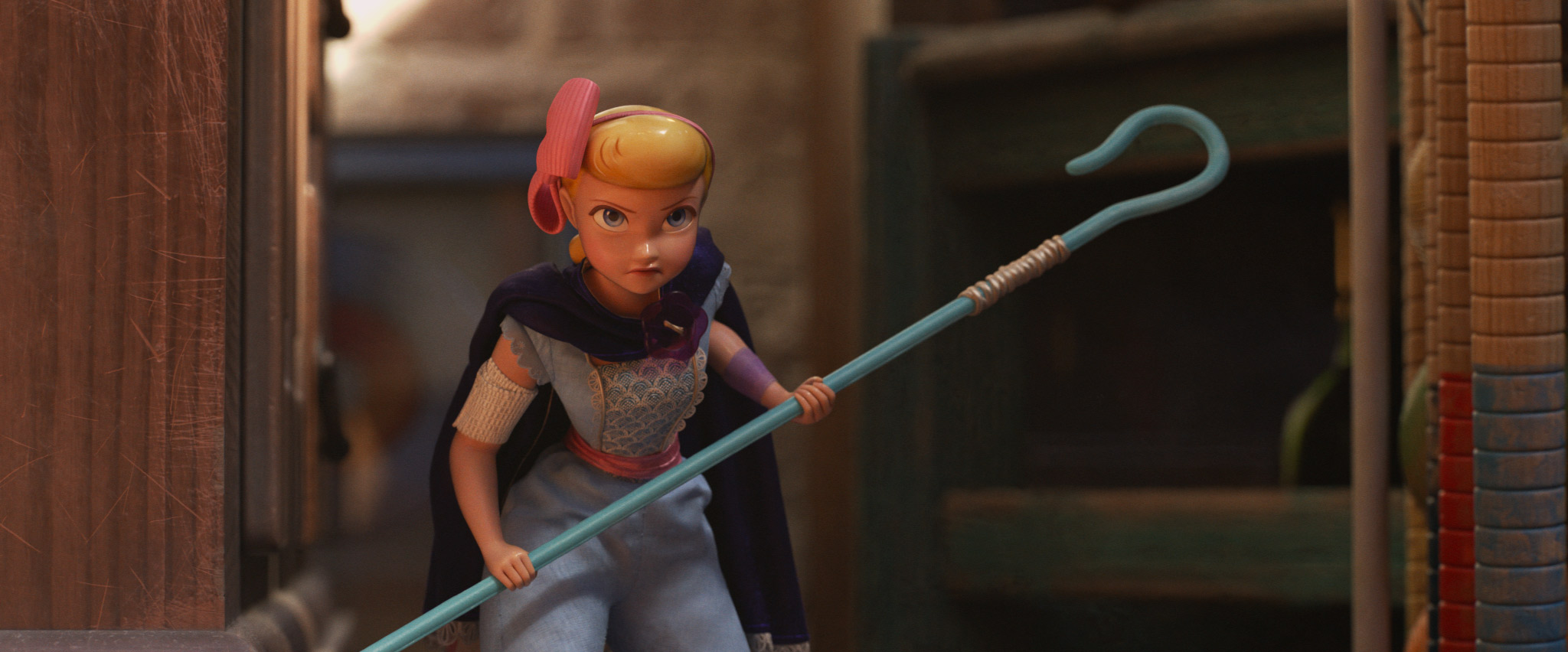 Valerie LaPointe — who is the head of story — she suggested that after that moment in the alley, Bo decides to take off and then having this like moment where she goes she decides to go back for Woody. So we kind of crufted those all together — and by then we’d lost our story department. We only had a couple of people so we used whatever storyboards we had from previous versions. And sometimes we cut it together as a radio play with descriptions of the scene then shipped that off to layout — which is not a normal way of doing things.
Valerie LaPointe — who is the head of story — she suggested that after that moment in the alley, Bo decides to take off and then having this like moment where she goes she decides to go back for Woody. So we kind of crufted those all together — and by then we’d lost our story department. We only had a couple of people so we used whatever storyboards we had from previous versions. And sometimes we cut it together as a radio play with descriptions of the scene then shipped that off to layout — which is not a normal way of doing things.
Then we cut it together more like a live-action movie in some ways. Some of the beats we already had from other versions, so it was like this weird hybrid of all those things. We were using a lot of temp music from Toy Story films. We’d already recorded a bunch of stuff with Randy, but we hadn’t recorded that scene yet.
We used some music from some of the Toy Story films there and then some other stuff from some other Randy scores and then we just kept on trying to like hone it and just make sure that we were really on target with what we were trying to say and what we were trying to do. Just be as specific as possible but not giving too much information because I think there was a whole thing where Bo gave a speech and then Woody gave a speech and it just felt like too much. It felt like we were telling the audience instead of showing, so we just pulled all that stuff out.
We also had a big speech at that at the end with Woody and Buzz and Bo — there was too much talking. I remember pulling out all the words and just using the words that Tom Hanks had said in between the lines to try and convey meaning.
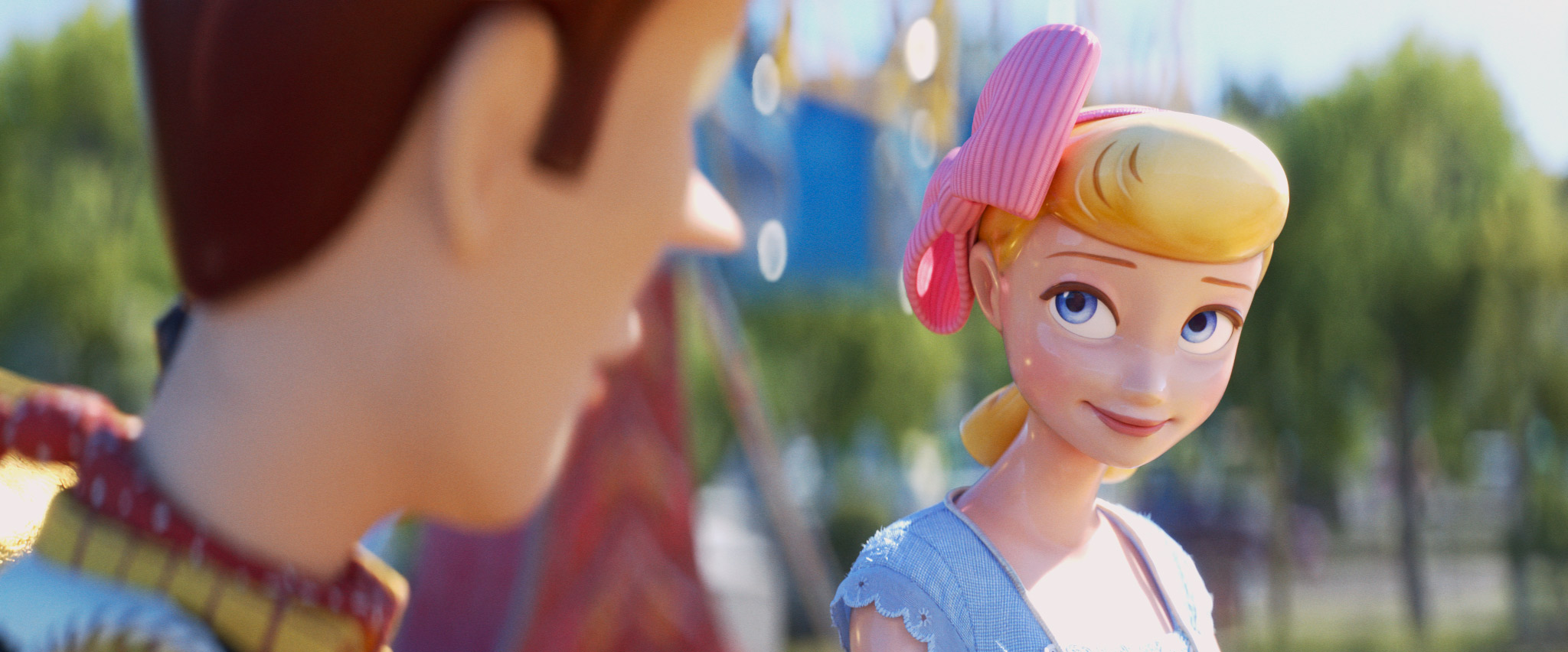 It felt more emotional that he couldn’t really talk. He didn’t want to say goodbye to Bo. He didn’t want to say goodbye to Buzz. He was torn between love and duty. And I think ultimately what tipped him over towards love is the fact that he’s actually doing love AND duty, but its duty of a new variety. He can go out there and try to make a difference in the world.
It felt more emotional that he couldn’t really talk. He didn’t want to say goodbye to Bo. He didn’t want to say goodbye to Buzz. He was torn between love and duty. And I think ultimately what tipped him over towards love is the fact that he’s actually doing love AND duty, but its duty of a new variety. He can go out there and try to make a difference in the world.
It was a pretty great moment of pride for me when we showed it to Randy and he said, “That temp’s pretty good here.” That’s high praise, Mr. Newman.
HULLFISH: And composers just have to hate temp, but at least it was his own.
GEDDES: I think that was probably part of his joke. One of the things we had going for us was when you get to the end of the movie effectively, and Woody and Bo have said goodbye to our gang and Bonnie and her family have driven off in the RV, we see Woody and Bo on top of the carousel and they had their kind of playful moment and we tilt up and reveal the moon — we have this big cue. A big classic movie cue that says, “This is right.” And it feels emotional and has this big emotional heft to it.
But we also hedged our bets by having that epilogue at the end with a bunch of goofy fun gags.
HULLFISH: You don’t wanna walk out of the theater after Axel Geddes’ name comes on the screen.
GEDDES: You want to feel pretty good and have some good giggles after that.
HULLFISH: Thank you so much for a wonderful conversation. I loved talking about story and emotion and all that stuff with you. Super great conversation. Thank you for your time.
GEDDES: My pleasure Steve. Really nice to meet you.
HULLFISH: Nice to meet you too.
To read other animation editing interviews, check out:
War for the Planet of the Apes
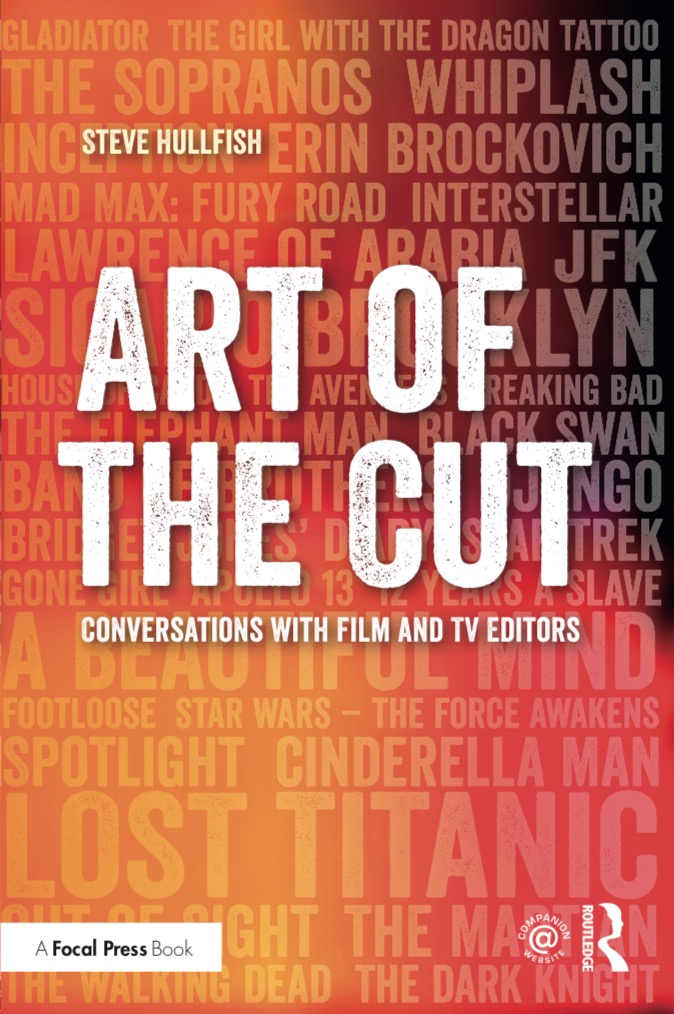
To read more interviews in the Art of the Cut series, check out THIS LINK and follow me on Twitter @stevehullfish or on imdb.
The first 50 interviews in the series provided the material for the book, “Art of the Cut: Conversations with Film and TV Editors.” This is a unique book that breaks down interviews with many of the world’s best editors and organizes it into a virtual roundtable discussion centering on the topics editors care about. It is a powerful tool for experienced and aspiring editors alike. Cinemontage and CinemaEditor magazine both gave it rave reviews. No other book provides the breadth of opinion and experience. Combined, the editors featured in the book have edited for over 1,000 years on many of the most iconic, critically acclaimed and biggest box office hits in the history of cinema.

Filmtools
Filmmakers go-to destination for pre-production, production & post production equipment!
Shop Now